Durability Analysis of Cold Spray Repairs: Phase I—Effect of Surface Grit Blasting
Abstract
1. Introduction
- (i)
- the analysis was performed using LEFM;
- (ii)
- the initial crack sizes were smaller than or comparable to the mandated EIDS;
- (iii)
- the experimentally measured crack growth histories were compared with predictions;
- (iv)
- and the experimental test results were used to generate the variability in the da/dN versus ΔK curves that are needed to enable a worst-case analysis, as mandated in the NASA Fracture Control Handbook NASA-HDBK-1510 [18].
2. Materials and Methods
2.1. The Geometric Dimensions and the Applied Marker Block Load Spectra
| Spectrum | Pmax | Cycles | Repeat Blocks | Cycles | Repeat Blocks | Cycles | Repeat Blocks | |||
|---|---|---|---|---|---|---|---|---|---|---|
| kN | R = 0.1 | R = 0.8 | R = 0.2 | R = 0.8 | R = 0.2 | R = 0.8 | ||||
| 1 | 35 | 5000 | 18,000 | To failure | - | - | - | - | - | - |
| 2 | 30 | 500 | 18,000 | To failure | - | - | - | - | - | - |
| 3 * | 30 | 300 | 15,000 | To failure | - | - | - | - | - | - |
| 4 | 26.77 | 500 | 18,000 | To failure | - | - | - | - | - | - |
| 5 | 26.77 | 300 | 15,000 | To failure | - | - | - | - | - | - |
| 6 | 26.77 | 300 | 15,000 | 15 | 200 | 10,000 | 15 | 100 | 3000 | To failure |
2.2. Stress Analysis and Durability Analyses
3. Comparison of the Measured and Computed Crack Growth Histories
3.1. Measured and Computed Results for the Specimens Used Spectrum 1
- Specimen Number 75_1_NC_1_#1
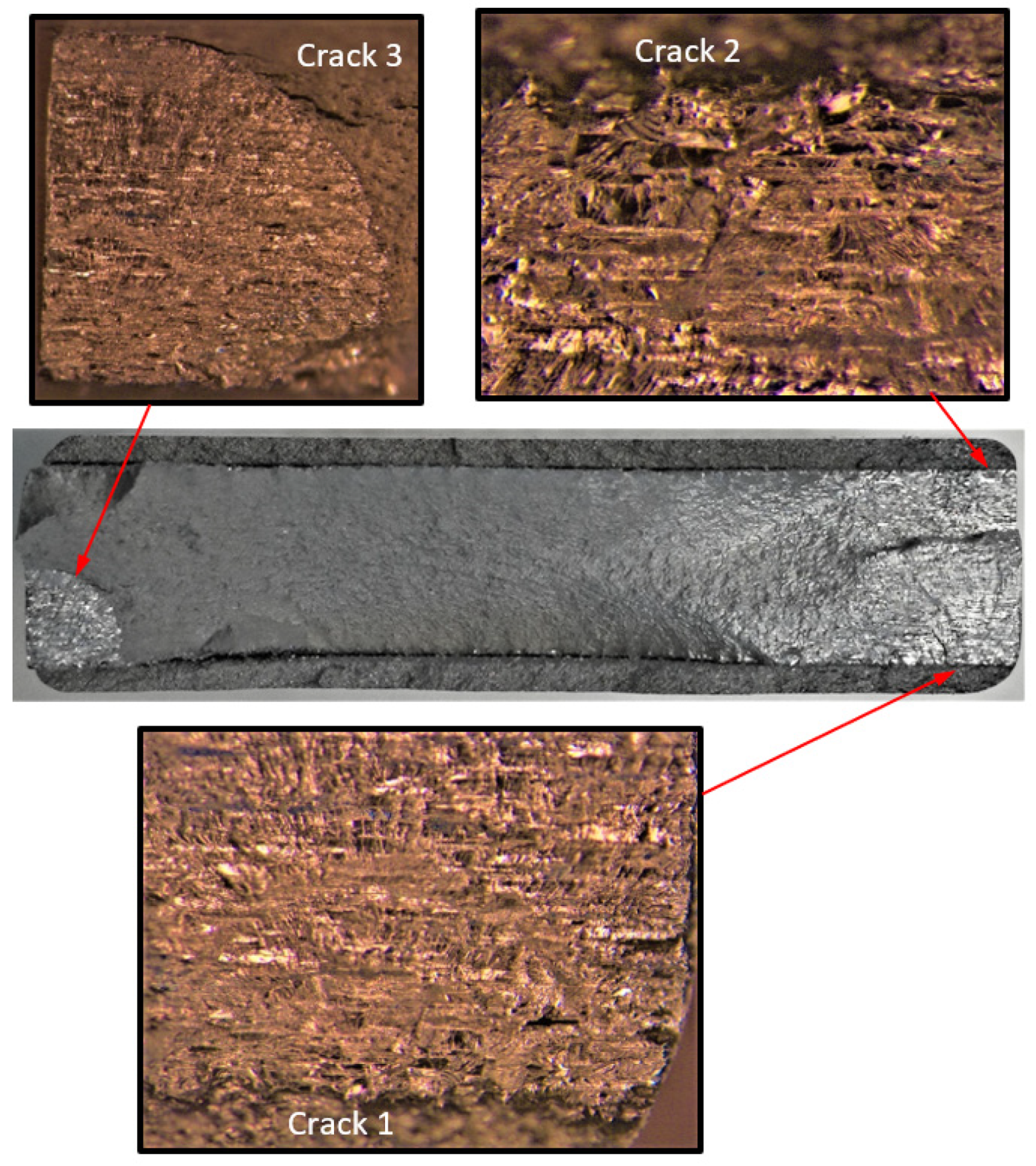
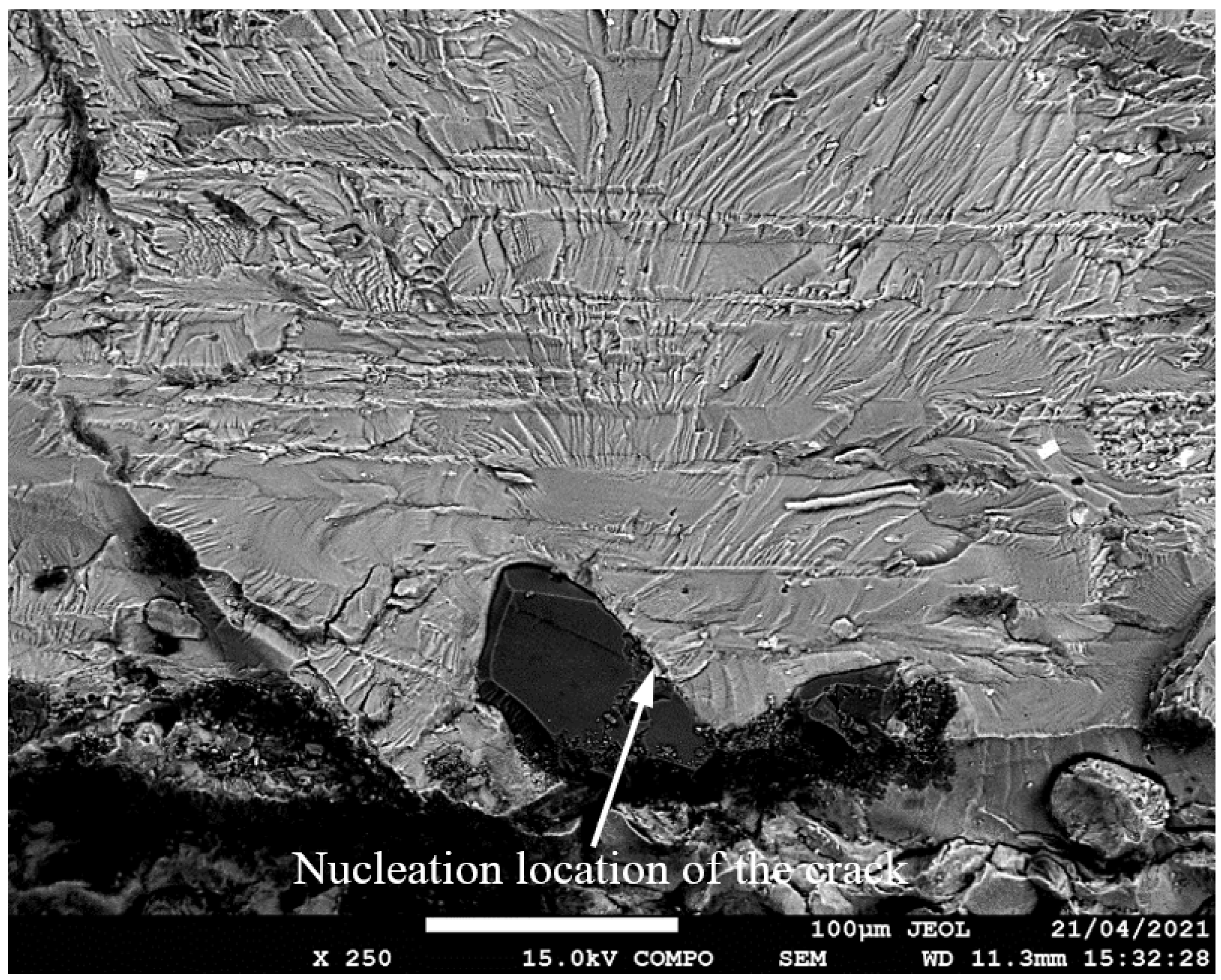

- 2.
- Specimen Number 75_1_NC_2_#2
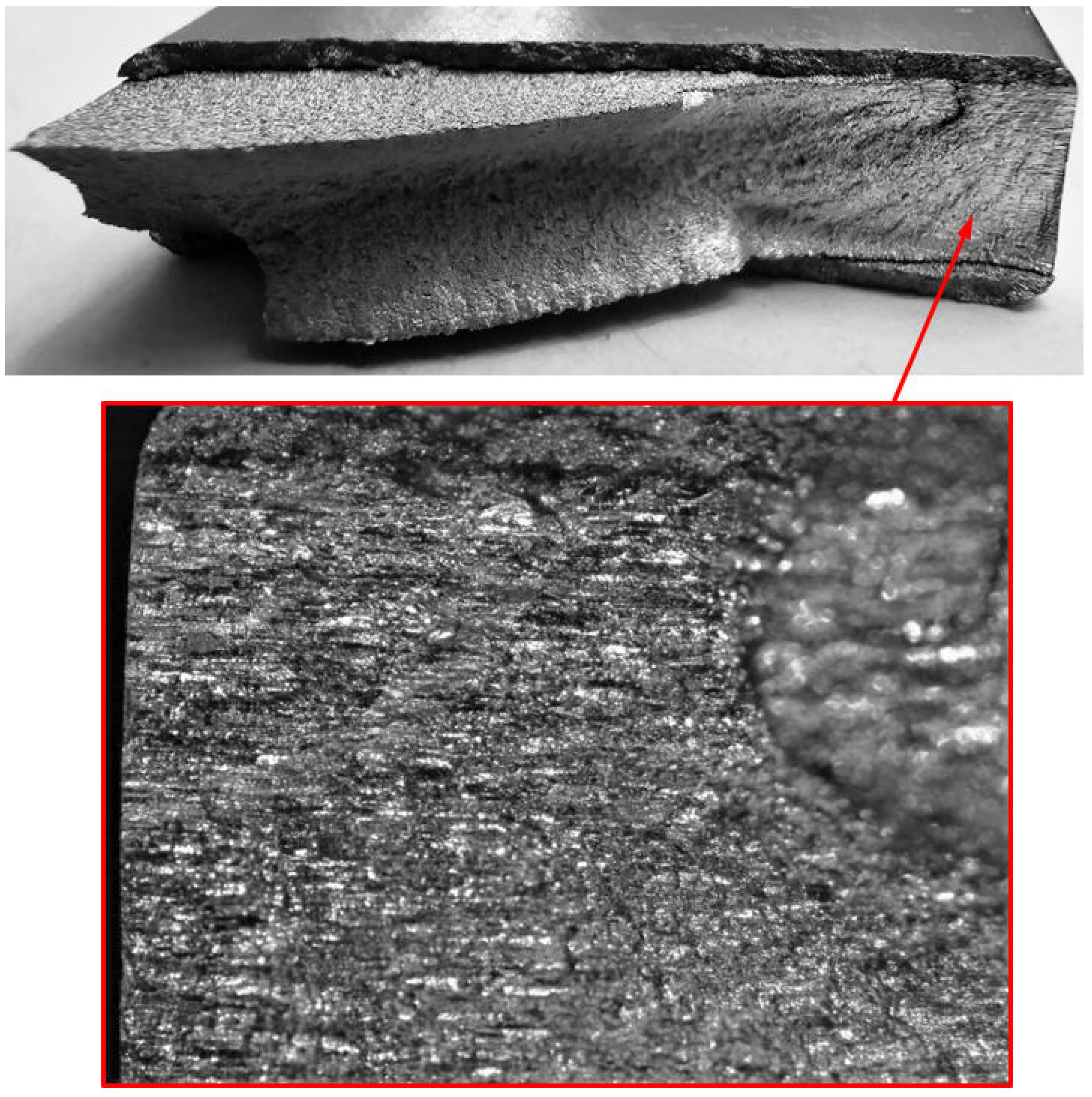
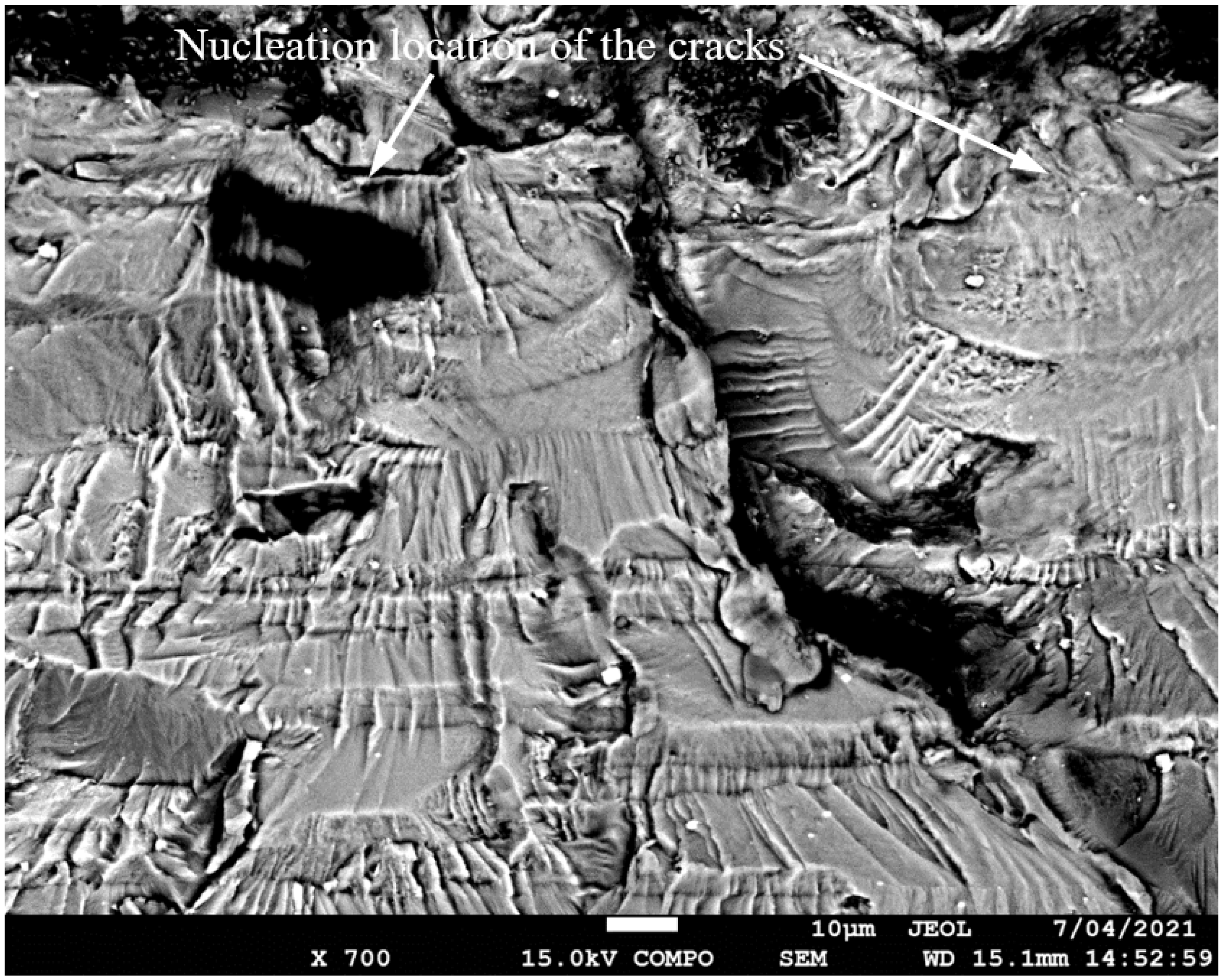
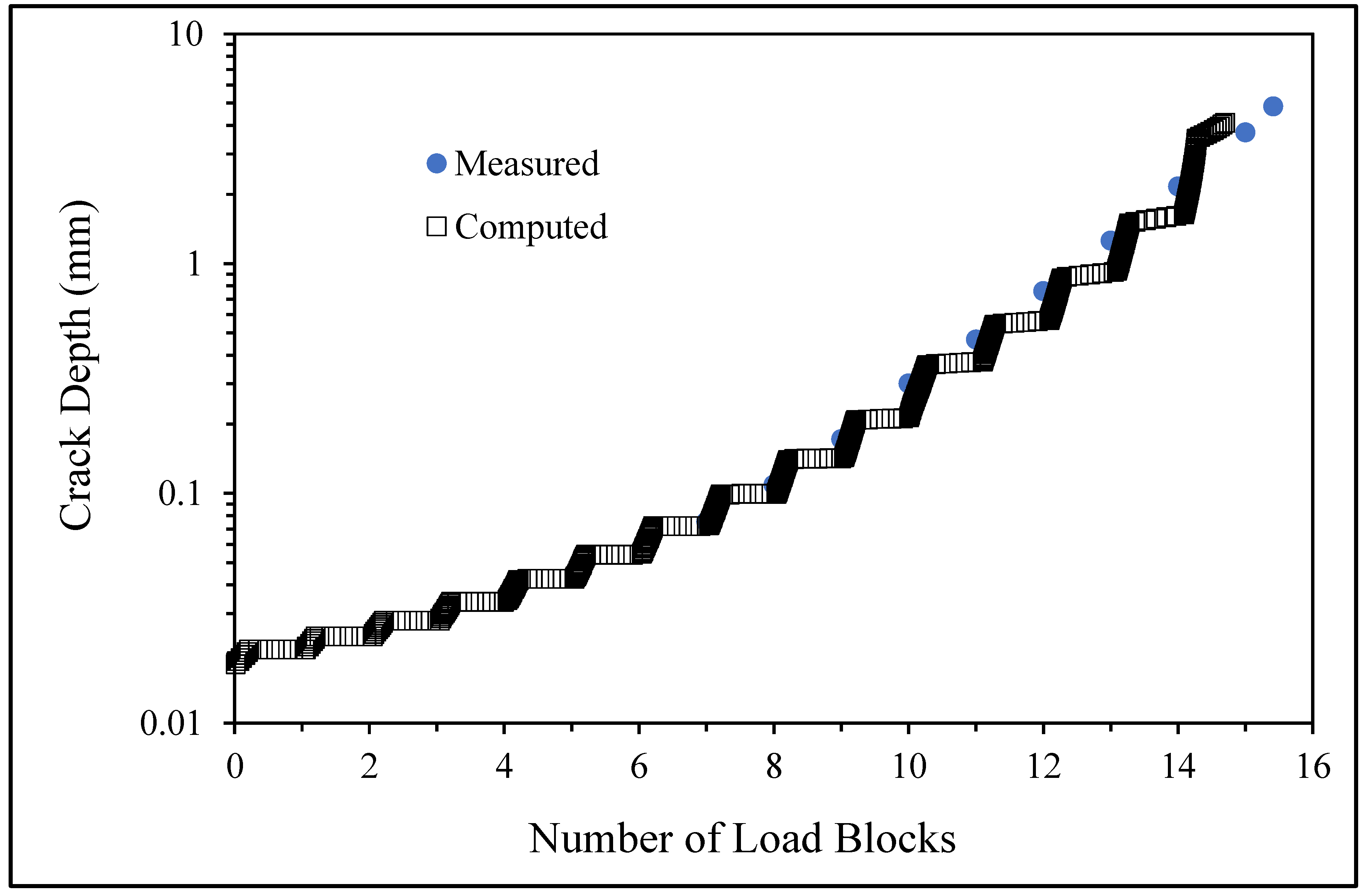
3.2. Measured and Computed Results for the Specimens Tested under Spectrum 2
- Specimen Number 75_1_NC_1_#2
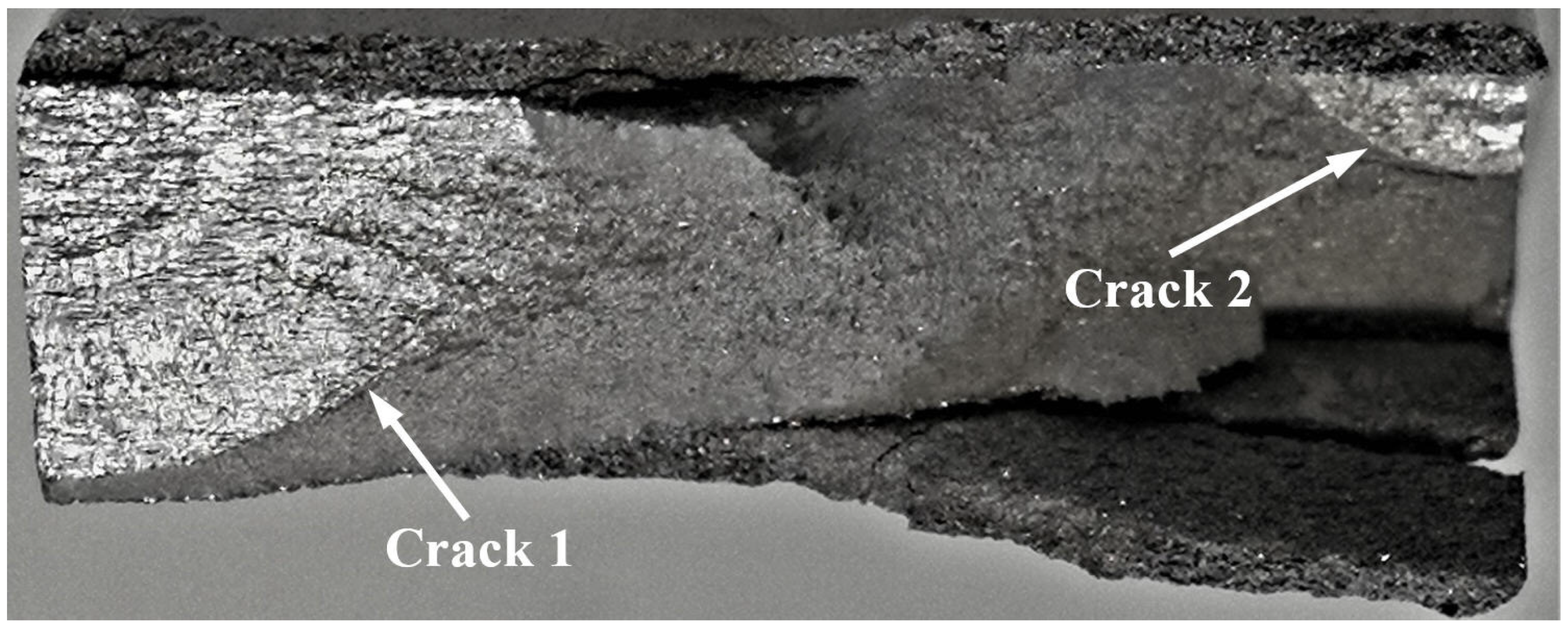


3.3. Measured and Computed Results for the Specimens Using Spectrum 3
- Specimen Number 75_1_NC_2_#3
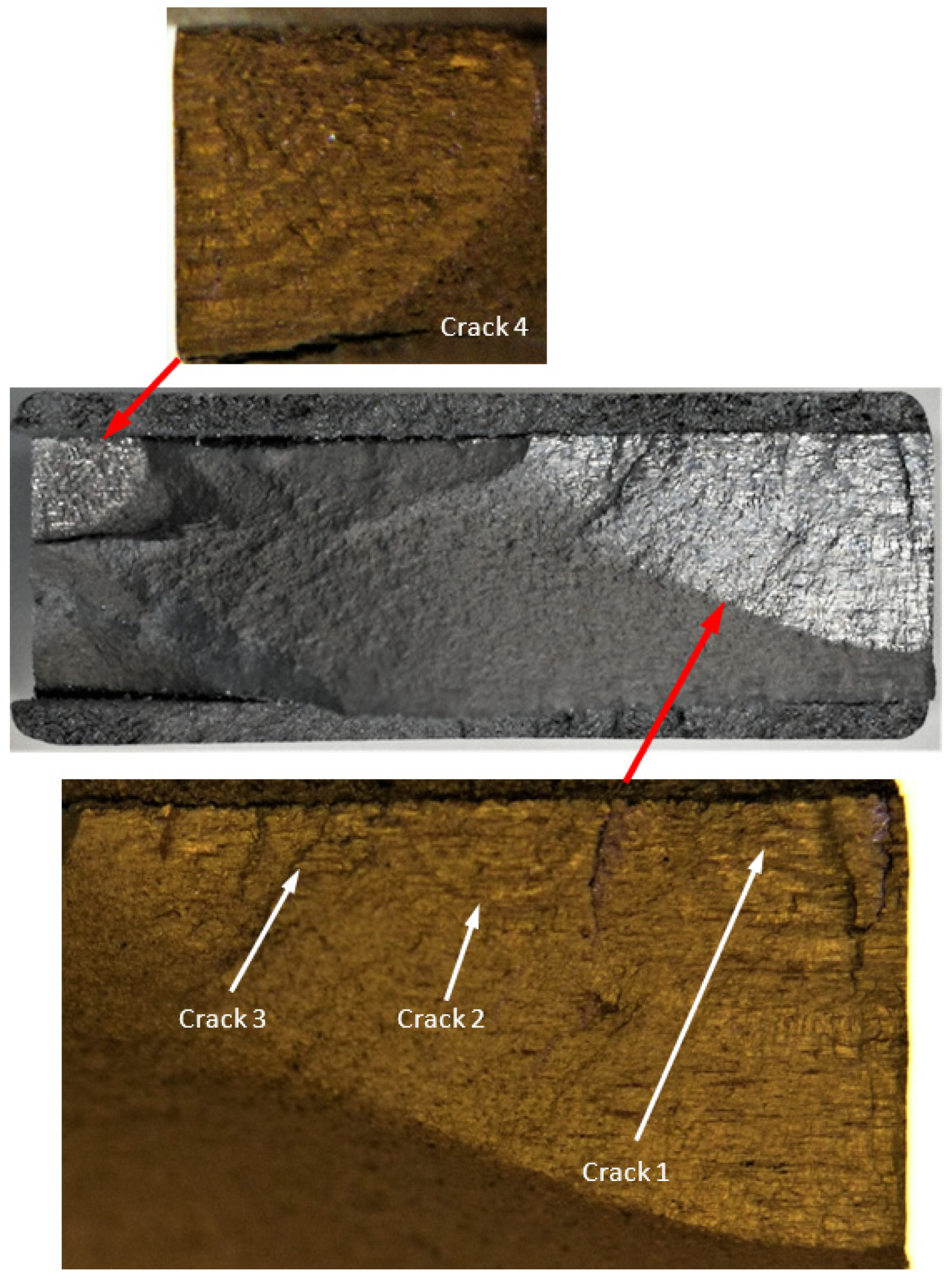

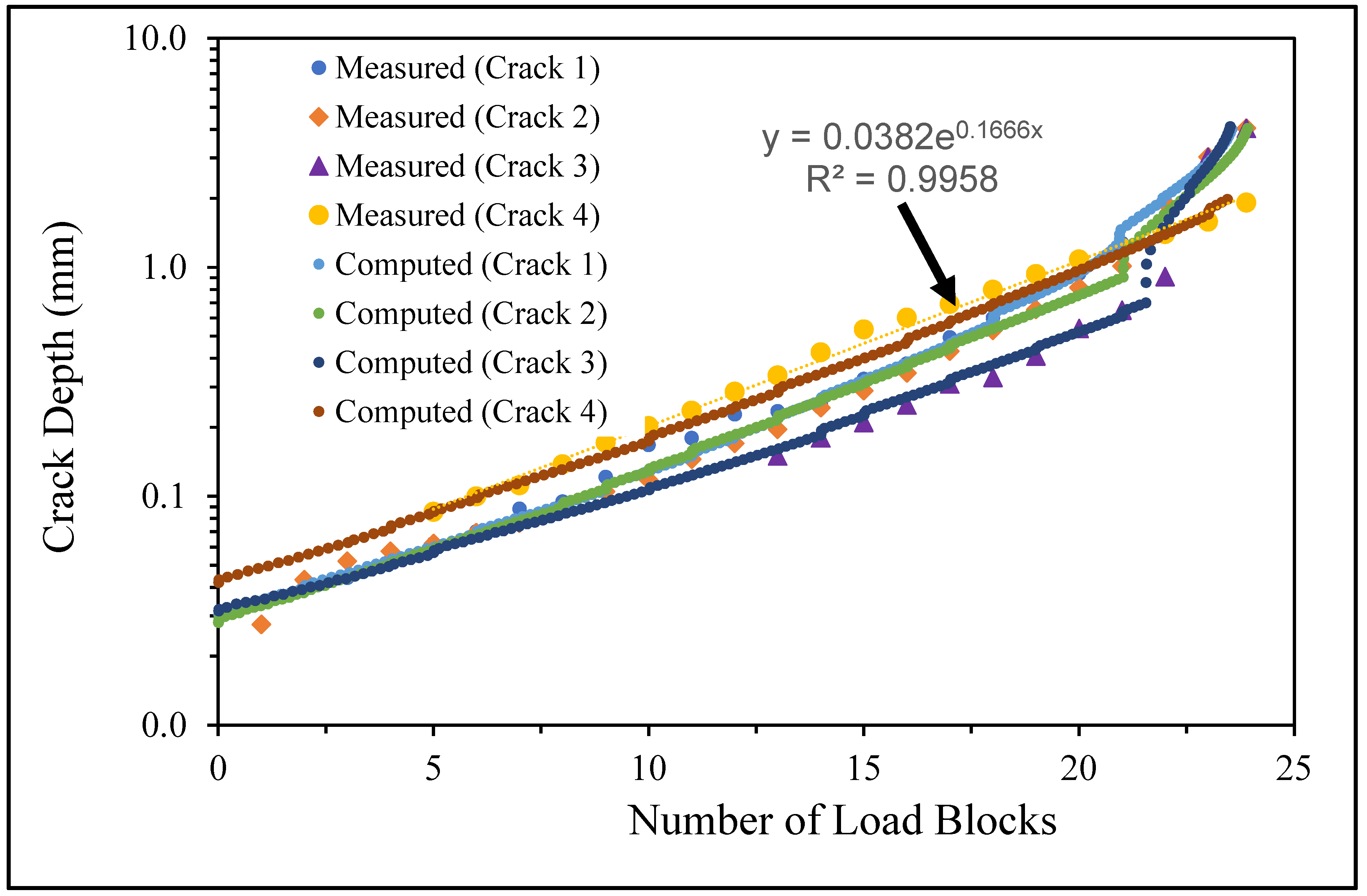
- 2.
- Specimen Number B_1_1_#1
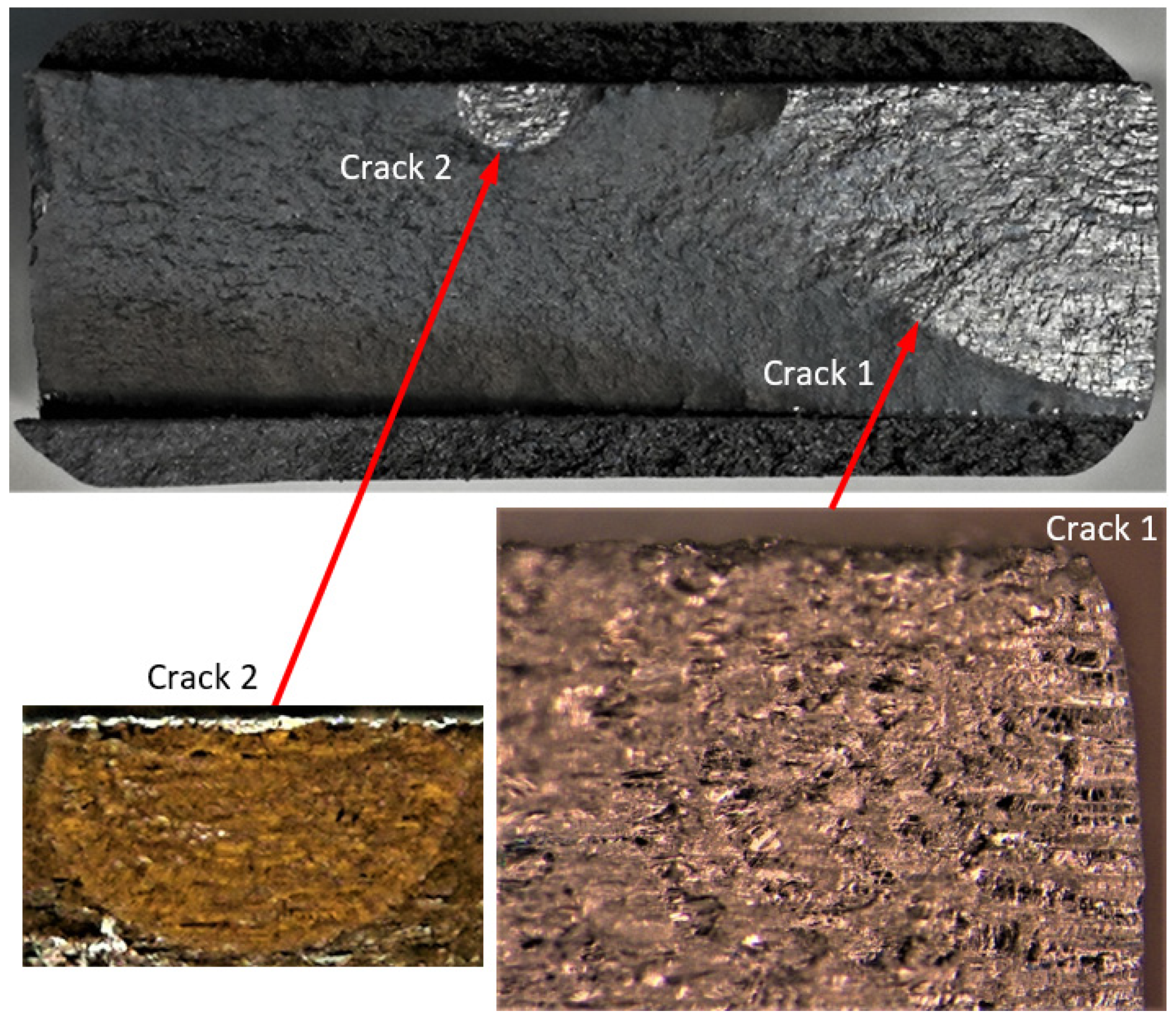

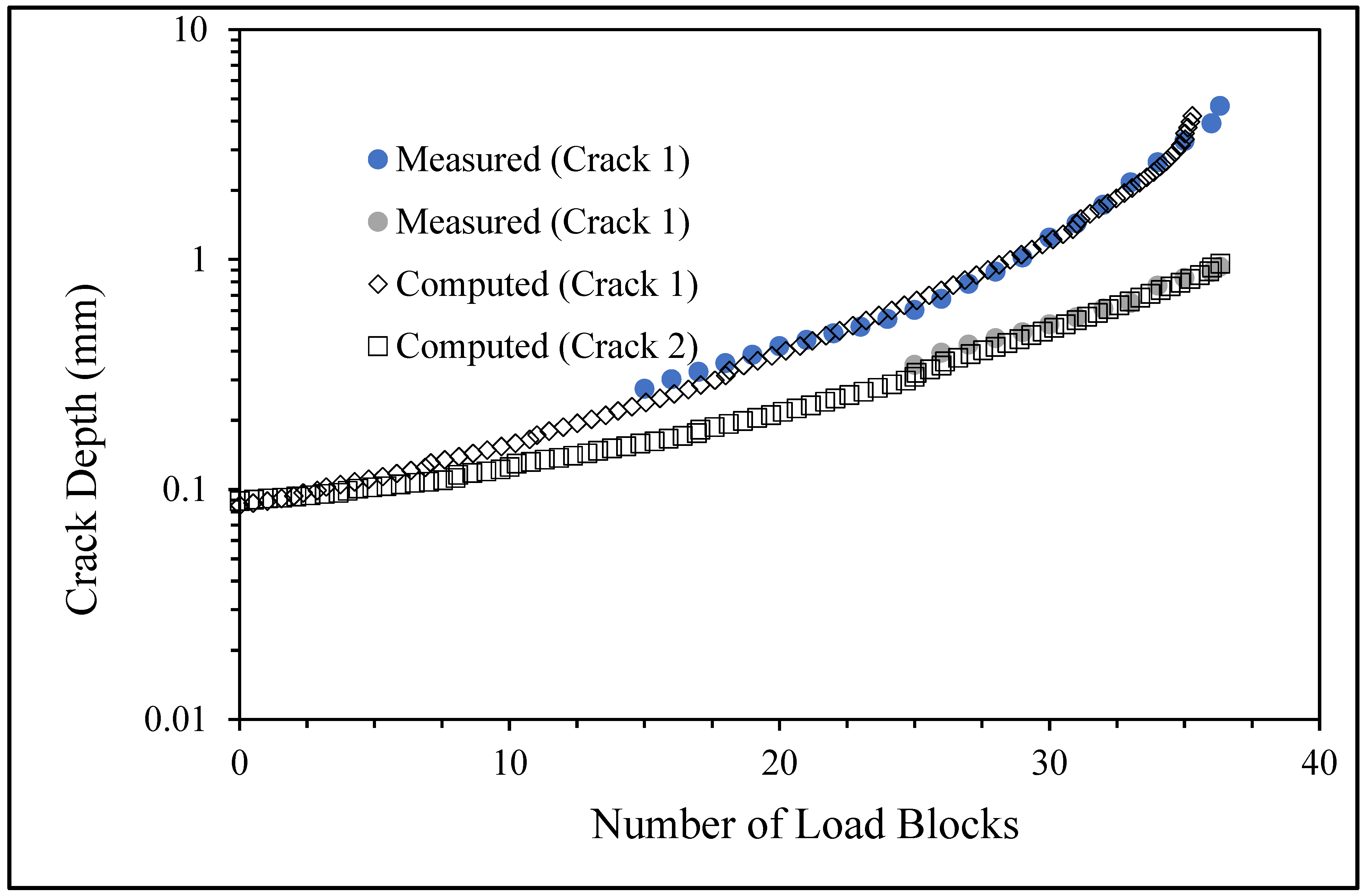
3.4. Measured and Computed Results for the Specimens Used Spectrum 4
- Specimen Number 75_1_NC_1_#3


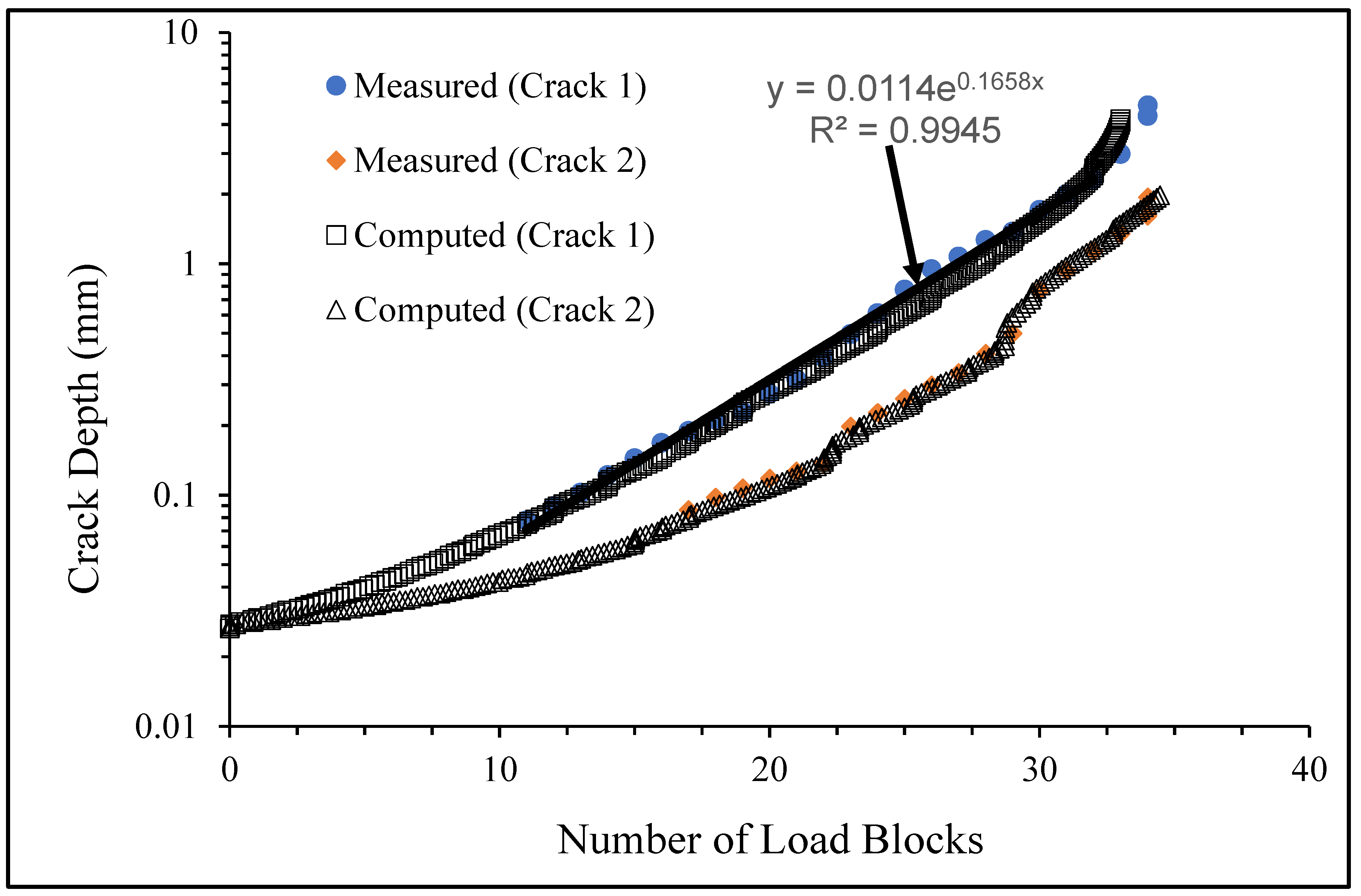
3.5. Measured and Computed Results for the Specimens Used Spectrum 5
- Specimen Number 75_1_NC_1_#4



- 2.
- Specimen Number 75_1_NC_2_#4

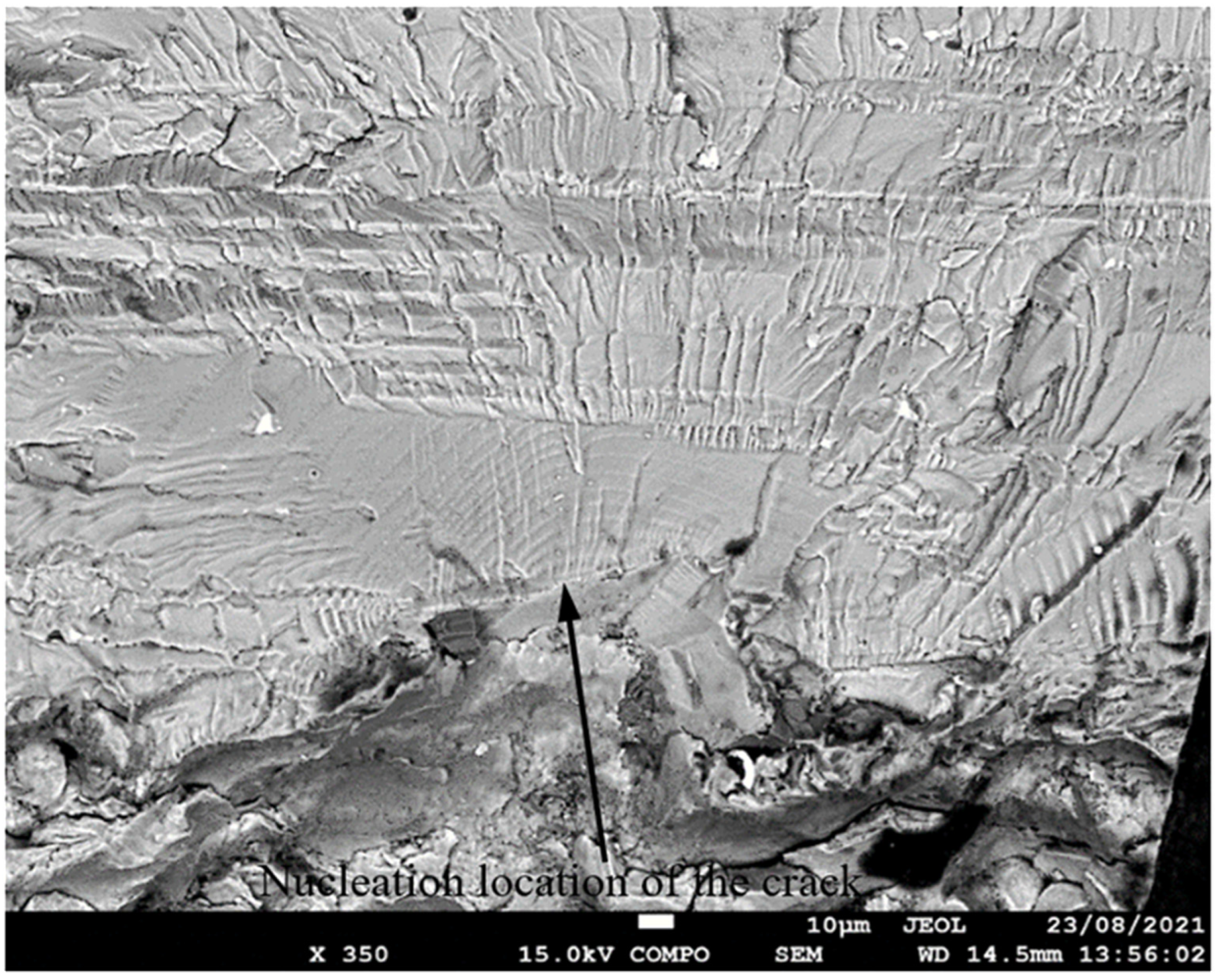

- 3.
- Specimen Number 75_1_NC_2_#5

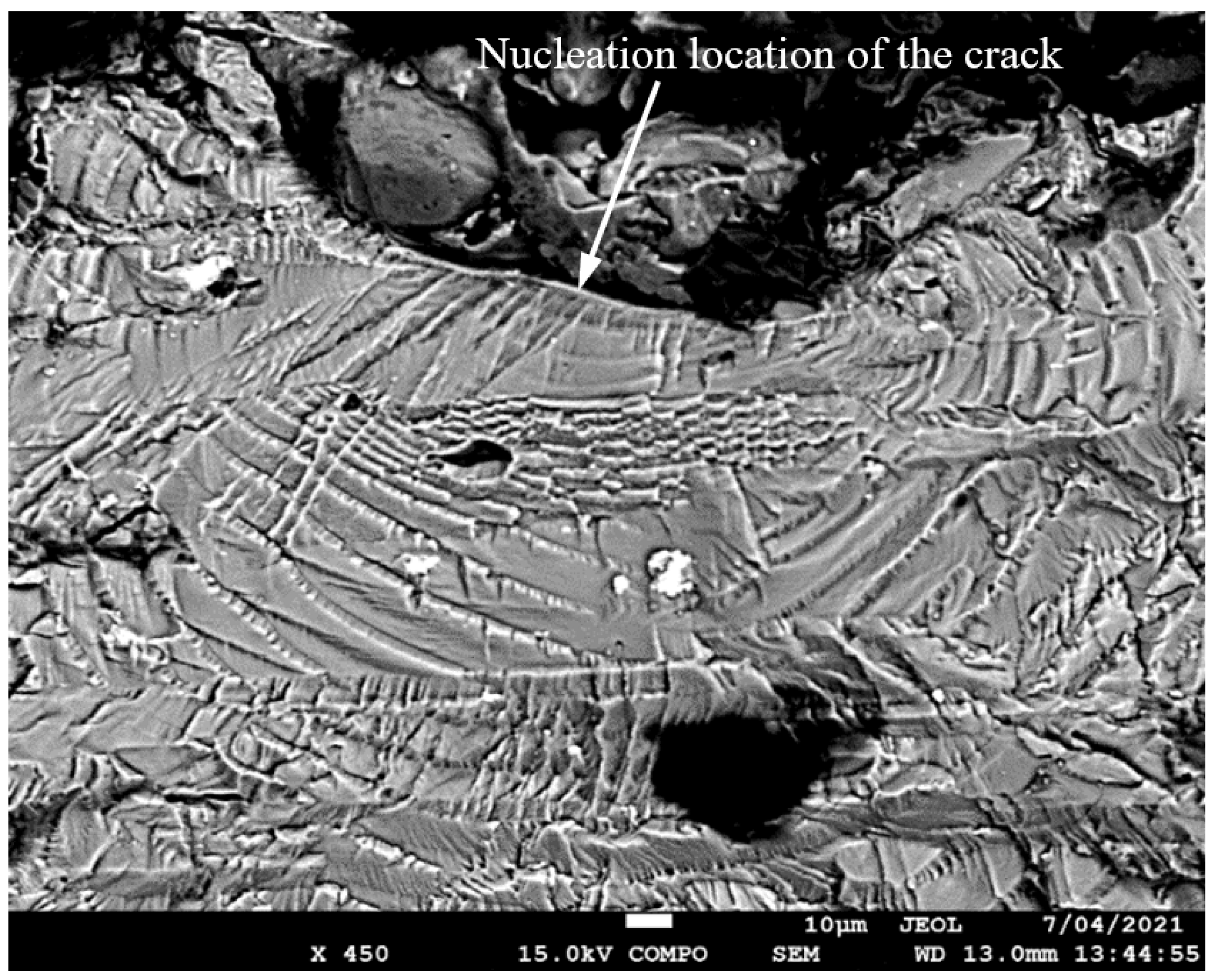
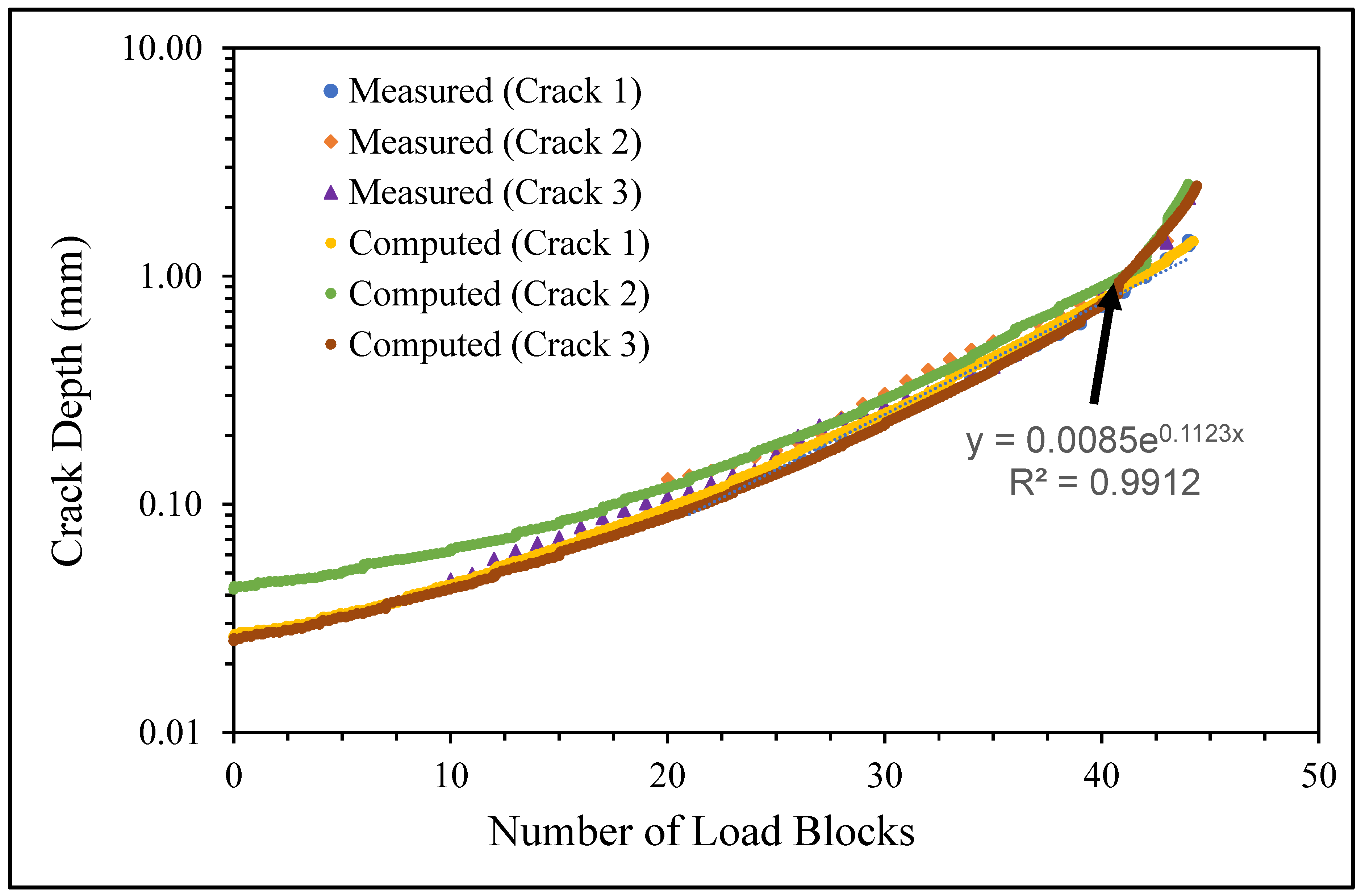
- 4.
- Specimen Number B_1_1_#2
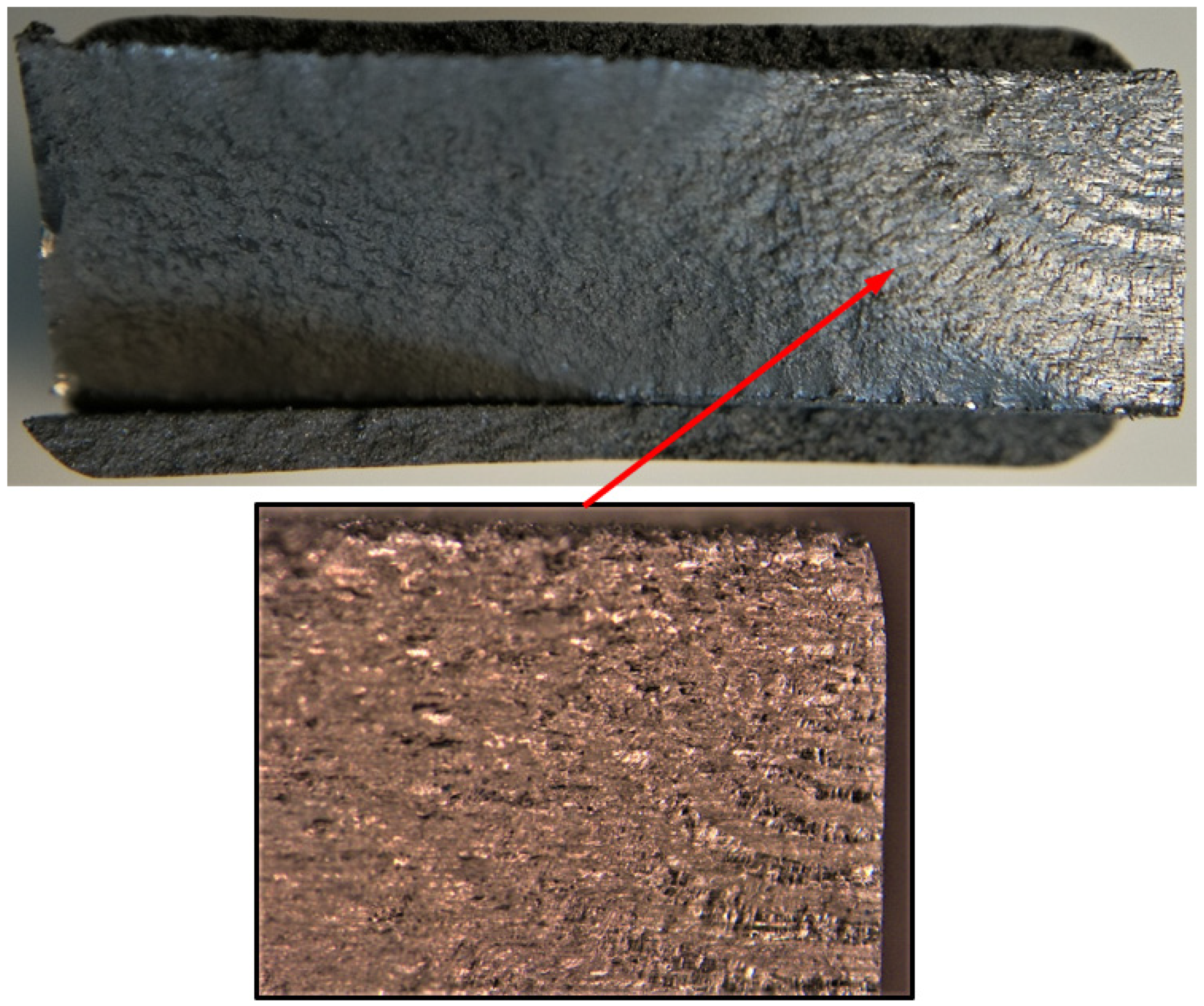
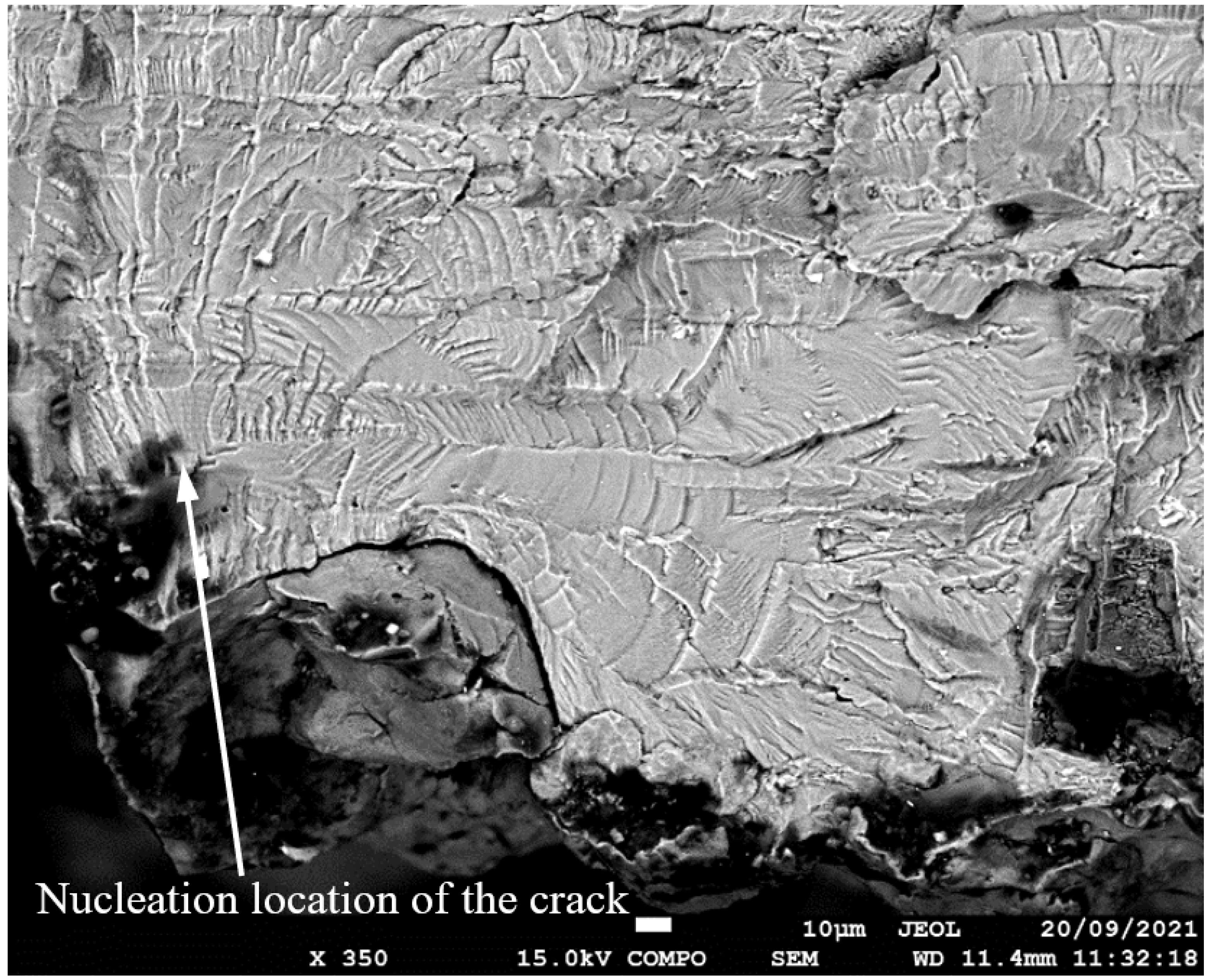
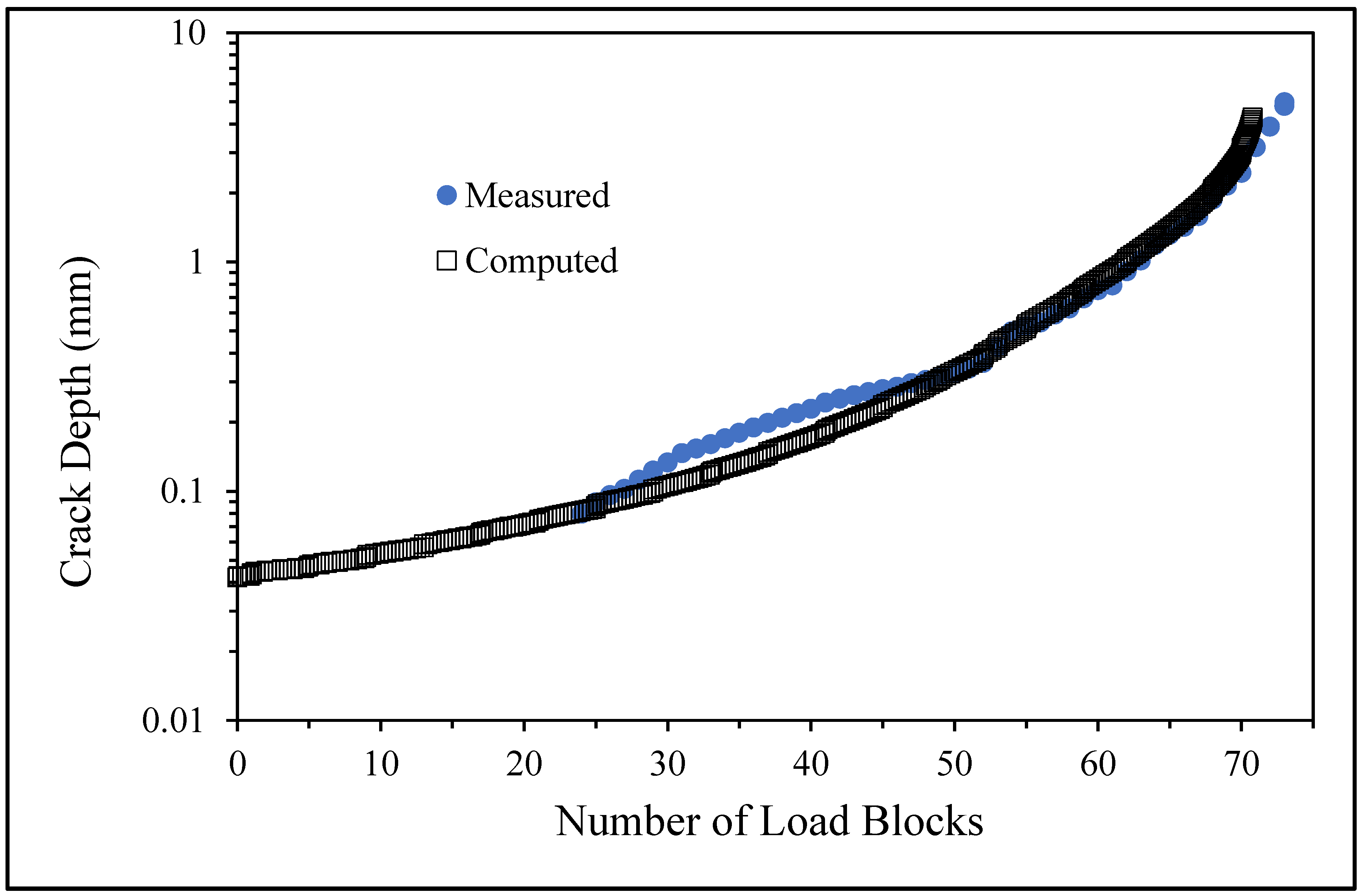
- 5.
- Specimen Number B_1_1_#3


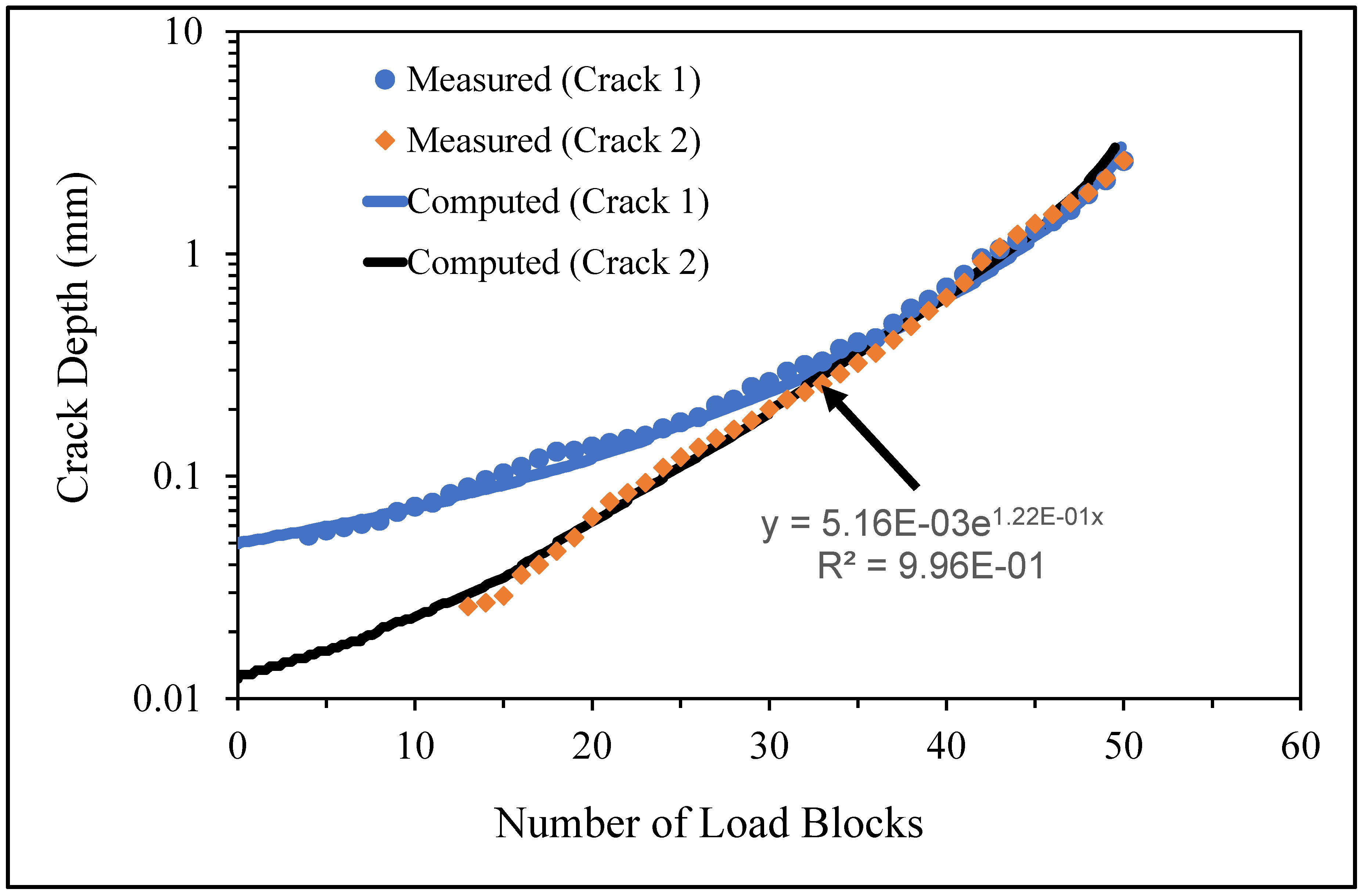
3.6. Measured and Computed Results for the Specimens Used Spectrum 6
- Specimen Number 75_1_NC_1_#5
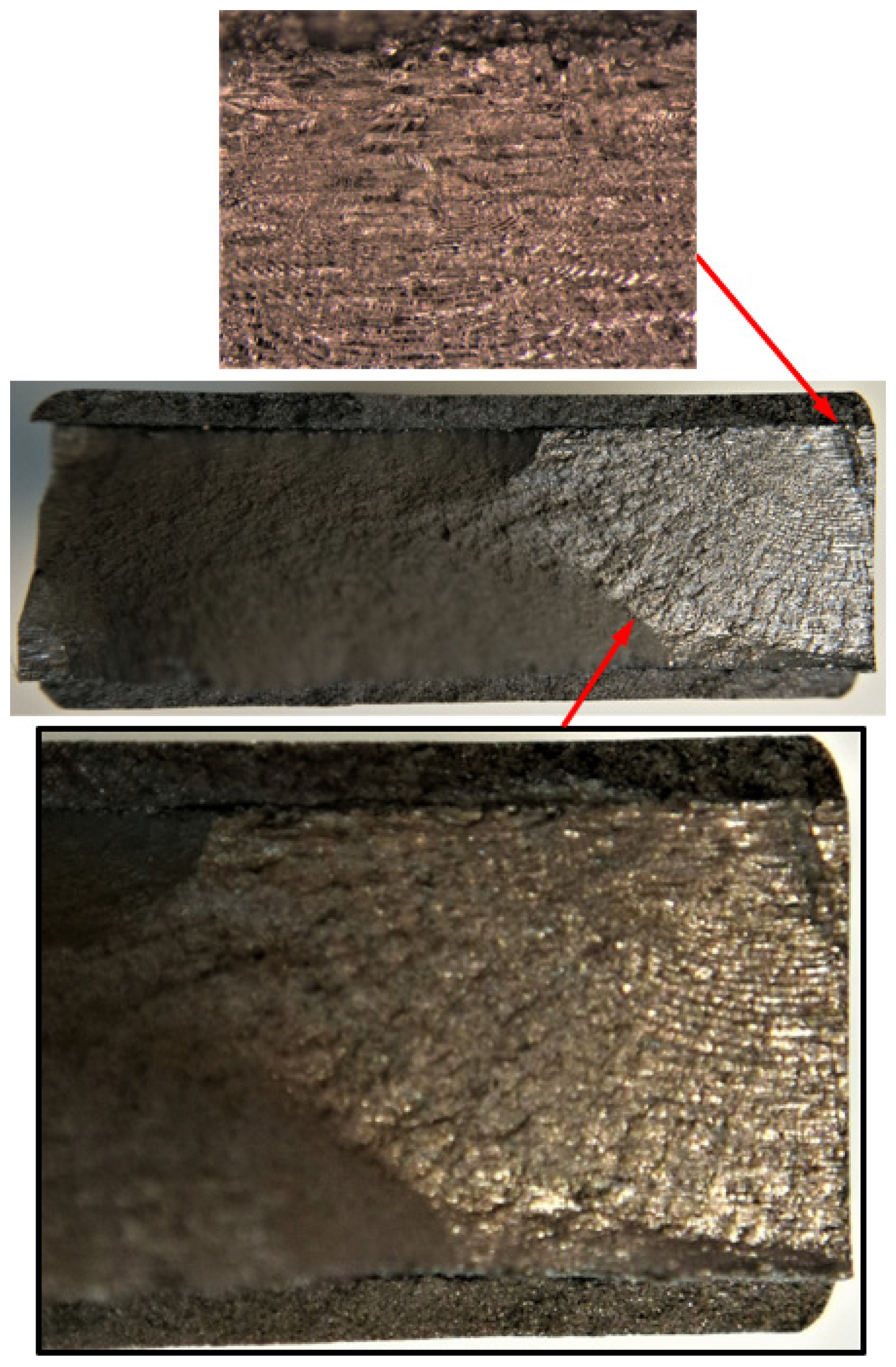

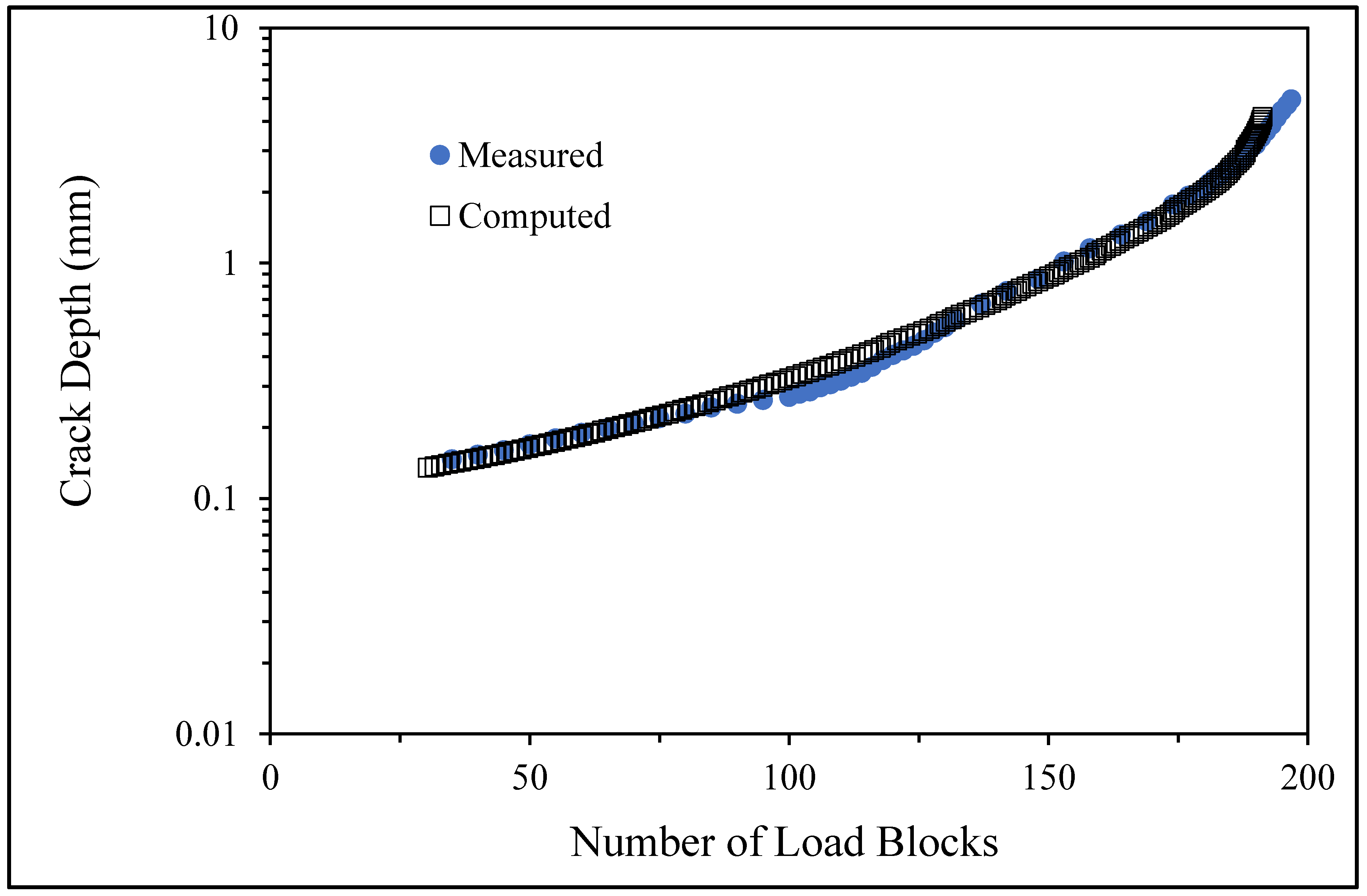
4. Assessment of the Computed versus Measured Crack Growth Histories
- (i)
- (ii)
- The computed and measured crack growth histories agree well for each of the twenty-five cracks.
- (iii)
- Table 3 reveals that the value of ΔKthr associated with the majority of the twenty-five cracks falls within the range of 0.0 to (approximately) 0.3 MPa √m, which is commonly seen for small cracks in conventionally manufactured aluminium alloys [21,23,25,64,71], as well as for small naturally occurring cracks in additively manufactured parts [37,72,73,74,75].
- (iv)
Variability in the Crack Growth Curves and NASA-HDBK-5010
5. Conclusions
Author Contributions
Funding
Institutional Review Board Statement
Informed Consent Statement
Data Availability Statement
Acknowledgments
Conflicts of Interest
References
- Jones, R.; Matthews, N.; Baker, A.; Champagne, V. Aircraft Sustainment and Repair; Butterworth-Heinemann Press: Oxford, UK, 2018; ISBN 978008100548. [Google Scholar]
- Champagne, V.K. The Cold Spray Materials Deposition Process Fundamentals and Applications; Woodhead Publishing Ltd.: Cambridge, UK, 2007; ISBN 978-1-84569-181-3. [Google Scholar]
- Champagne, V., Jr.; Matthews, N.; Champagne, V., III. Chapter 14: Introduction to Supersonic Particle Deposition. In Aircraft Sustainment and Repair; Jones, R., Matthews, N., Baker, A., Champagne, V., Eds.; Butterworth-Heinemann Press: Oxford, UK, 2018; pp. 799–844. ISBN 9780081005408. [Google Scholar]
- Matthews, N. Chapter 15: Additive Metal Technologies for Aerospace Sustainment. In Aircraft Sustainment and Repair; Jones, R., Matthews, N., Baker, A., Champagne, V., Eds.; Butterworth-Heinemann Press: Oxford, UK, 2018; pp. 845–862. ISBN 9780081005408. [Google Scholar]
- Bagherifard, S.; Guagliano, M. Fatigue performance of cold spray deposits: Coating, repair and additive manufacturing cases. Int. J. Fatigue 2020, 139, 105744. [Google Scholar] [CrossRef]
- Champagne, V.; Helfritch, D. Critical Assessment 11: Structural repairs by cold spray. Mater. Sci. Technol. 2015, 31, 627–634. [Google Scholar] [CrossRef]
- Widener, C.A.; Ozdemir, O.C.; Carter, M. Structural repair using cold spray technology for enhanced sustainability of high value assets. Procedia Manuf. 2018, 21, 361–368. [Google Scholar] [CrossRef]
- Yin, S.; Cavaliere, P.; Aldwell, B.; Jenkins, R.; Liao, H.; Li, W.; Lupoi, R. Cold spray additive manufacturing and repair: Fundamentals and applications. Addit. Manuf. 2018, 21, 628–650. [Google Scholar] [CrossRef]
- Pathak, S.; Saha, G.C. Development of Sustainable Cold Spray Coatings and 3D Additive Manufacturing Components for Repair/Manufacturing Applications: A Critical Review. Coatings 2017, 7, 122. [Google Scholar] [CrossRef]
- Kundu, S.; Jones, R.; Peng, D.; Matthews, N.; Alankar, A.; Singh, R.K.R.; Huang, P. Review of Requirements for the Durability and Damage Tolerance Certification of Additively Manufactured Aircraft Structural Parts and AM Repairs. Materials 2020, 13, 1341. [Google Scholar] [CrossRef] [PubMed]
- Department of Defense Joint Service Specification Guide, Aircraft Structures. JSSG-2006. October 1998. Available online: http://everyspec.com/USAF/USAF-General/JSSG-2006_10206/ (accessed on 2 May 2024).
- Department of Defense Standard Practice Aircraft Structural Integrity Program (ASIP). MIL-STD-1530D. 13 October 2016. Available online: http://everyspec.com/MIL-STD/MIL-STD-1500-1599/MIL-STD-1530D_55392/ (accessed on 27 May 2024).
- Durability and Damage Tolerance Certification for Additive Manufacturing of Aircraft Structural Metallic Parts; Structures Bulletin EZ-SB-19-01; Wright Patterson Air Force Base: Dayton, OH, USA, 2019; Available online: https://daytonaero.com/usaf-structures-bulletins-library/ (accessed on 2 May 2024).
- White, B.; Story, W.; Brewer, L.; Jordon, J.B. Fatigue behaviour of fastener holes in high-strength aluminum plates repaired by cold spray deposition. Fatigue Fract. Eng. Mater. Struct. 2019, 43, 317–329. [Google Scholar] [CrossRef]
- Yandouzi, M.; Gaydos, S.; Guo, D.; Ghelichi, R.; Jodoin, B. Aircraft Skin Restoration and Evaluation. J. Therm Spray Technol. 2006, 23, 1281–1290. [Google Scholar] [CrossRef]
- Peng, D.; Tang, C.; Matthews, N.; Jones, R.; Kundu, S.; Singh Raman, R.K.; Alankar, A. Computing the Fatigue Life of Cold Spray Repairs to Simulated Corrosion Damage. Materials 2021, 14, 4451. [Google Scholar] [CrossRef]
- Peng, D.; Jones, R.; Matthews, N.; Tang, C. On the role of the interface on the damage tolerance and durability of cold spray repairs to AA7075-T7351 aluminium alloy wing skins. Appl. Surf. Sci. Adv. 2020, 3, 100052. [Google Scholar] [CrossRef]
- Fracture Control Handbook for Payloads, Experiments, and Similar Hardware. NASA-HDBK-5010. May 2005, Revalidated 2012. Available online: https://standards.nasa.gov/standard/nasa/nasa-hdbk-5010 (accessed on 14 April 2024).
- Available online: https://vrcmetalsystems.com/brogla-002-mobile-cold-spray-system/ (accessed on 21 May 2024).
- Available online: https://www.navair.navy.mil/news/Rise-Cold-Spray-Technology-Fleet-Readiness-Center-Southwest/Thu-12142023-1318 (accessed on 21 May 2024).
- Jones, R. Fatigue crack growth and damage tolerance. Fatigue Fract. Eng. Mater. Struct. 2014, 37, 463–483. [Google Scholar] [CrossRef]
- Tan, J.L.; Chen, B.K. Prediction of fatigue life in aluminum alloy (AA7050-T7451) structures in the presence of multiple artificial short cracks. Theor. Appl. Fract Mech. 2015, 78, 1–7. [Google Scholar] [CrossRef]
- Tan, J.L.; Chen, B.K. Coalescence and growth of two coplanar short cracks in AA7050-T7451 aluminium alloys. Eng. Fract. Mech. 2013, 102, 324–333. [Google Scholar] [CrossRef]
- Tan, J.L.; Chen, B.K. A new fracture area method for predicting the growth of a newly coalesced crack in AA7050-T7451 aluminium alloy. Theor. Appl. Fract. Mech. 2015, 75, 146–150. [Google Scholar] [CrossRef]
- Main, B.; Evans, R.; Walker, K.; Yu, X.; Molent, L. Lessons from a Fatigue Prediction Challenge for an Aircraft Wing Shear Tie Post. Int. J. Fatigue 2019, 123, 53–65. [Google Scholar] [CrossRef]
- Godefroid, L.B.; Moreira, L.P.; Vilela, T.C.G.; Faria, G.L.; Candido, L.C.; Pinto, E.S. Effect of chemical composition and microstructure on the fatigue crack growth resistance of pearlitic steels for railroad application. Int. J. Fatigue 2019, 120, 241. [Google Scholar] [CrossRef]
- Kovarik, O.; Cizek, J.; Klecka, J. Fatigue Crack Growth Rate Description of RF-Plasma-Sprayed Refractory Metals and Alloys. Materials 2023, 16, 1713. [Google Scholar] [CrossRef] [PubMed]
- Khudiakova, A.; Brunner, A.J.; Wolfahrt, M.; Pinter, G. Quantification Approaches for Fatigue Crack Resistance of Thermoplastic Tape Layered Composites with Multiple Delaminations. Materials 2021, 14, 1476. [Google Scholar] [CrossRef]
- Riedl, G.; Pugstaller, R.; Wallner, G.M. Development and implementation of a simultaneous fatigue crack growth test setup for polymeric hybrid laminates. Eng. Fract. Mech. 2002, 267, 108468. [Google Scholar] [CrossRef]
- Simon, I.; Banks-Sills, L.; Fourman, V. Mode I delamination propagation and R-ratio effects in woven DCB specimens for a multi-directional layup. Int. J. Fatigue 2017, 96, 237–251. [Google Scholar] [CrossRef]
- Arhant, M.; Lolive, E.; Bonnemains, T.; Davies, P. Effect of aging on the fatigue crack growth properties of carbon-polyamide 6 thermoplastic composites using the multi ΔG-control method. Compos. Part A Appl. Sci. Manuf. 2022, 161, 107105. [Google Scholar] [CrossRef]
- Clerc, G.; Brunner, A.J.; Niemz, P.; Van De Kuilen, J.W.G. Feasibility study on Hartman-Schijve data analysis for mode II fatigue fracture of adhesively bonded wood joints. Int. J. Fatigue 2019, 221, 123–140. [Google Scholar] [CrossRef]
- Sanaei, N.; Fatemi, A. Defect-based multiaxial fatigue life prediction of L-PBF additive manufactured metals. Fatigue Fract. Eng. Mater. Struct. 2021, 44, 1897. [Google Scholar] [CrossRef]
- Sanaei, N.; Fatemi, A. Defect-based fatigue life prediction of L-PBF additive manufactured metals. Eng. Fract. Mech. 2021, 244, 107541. [Google Scholar] [CrossRef]
- Markham, M.J.; Fatemi, A.; Phan, N. Mixed-Mode Small Fatigue Crack Growth Rates and Modeling in Additively Manufactured Metals. Int. J. Fatigue 2024, 183, 108258. [Google Scholar] [CrossRef]
- Sanaei, N.; Fatemi, A. Defects in additive manufactured metals and their effect on fatigue performance: A state-of-the-art review. Prog. Mater. Sci. 2021, 117, 100724. [Google Scholar] [CrossRef]
- Dastgerdi, J.N.; Jaberi, O.; Remes, H.; Lehto, P.; Toudeshky, H.H.; Kuva, J. Fatigue damage process of additively manufactured 316L steel using X-ray computed tomography imaging. Addit. Manuf. 2023, 70, 103559. [Google Scholar] [CrossRef]
- Markham, M.J.; Fatemi, A. Multiaxial Fatigue Life Predictions of Additively Manufactured Metals using a Hybrid of Linear Elastic Fracture Mechanics and a Critical Plane Approach. Int. J. Fatigue 2024, 178, 107979. [Google Scholar] [CrossRef]
- Ye, J.; Syed, A.K.; Zhang, X.; Eimer, E.; Williams, S. Fatigue crack growth behaviour in an aluminium alloy Al-Mg-0.3Sc produced by wire based directed energy deposition process. Fatigue Fract. Eng. Mater. Struct. 2023, 46, 3927–3938. [Google Scholar] [CrossRef]
- Shamir, M.; Zhang, X.; Syed, A.K. Characterising and representing small crack growth in an additive manufactured titanium alloy. Eng. Fract. Mech. 2021, 253, 107876. [Google Scholar] [CrossRef]
- Elber, W. Fatigue crack cyclic closure under cyclic tension. Eng. Fract. Mech. 1970, 2, 37–45. [Google Scholar]
- ASTM STP 486; The Significance of Crack Closure. ASTM International: West Conshohocken, PA, USA, 1971; pp. 230–242.
- Kemp, R.M.J. Fatigue Crack Closure—A Review, Royal Aerospace Establishment; Technical Report 90046; Procurement Executive, Ministry of Defence: Farnborough, UK, 1990; Available online: https://apps.dtic.mil/sti/pdfs/ADA236760.pdf (accessed on 20 April 2024).
- Paris, P.C.; Tada, H.; Donald, J.K. Service load fatigue damage—A historical perspective. Int. J. Fatigue 1999, 21, S35–S46. [Google Scholar] [CrossRef]
- Paris, P.C.; Lados, D.; Tada, H. Reflections on identifying the real ΔKeffective in the threshold region and beyond. Eng. Fract. Mech. 2008, 75, 299–305. [Google Scholar] [CrossRef]
- Kujawski, D. Enhanced model of partial crack closure for correlation of R-ratio Effects in aluminium alloys. Int. J. Fatigue 2001, 23, 95–102. [Google Scholar] [CrossRef]
- Ribeiro, V.; Correia, J.; Lesiuk, G.; Gonçalves, A.; De Jesus, A.; Berto, F. Application and discussion of various crack closure models to predict fatigue crack growth in 6061-T651 aluminium alloy. Int. J. Fatigue 2021, 153, 106472. [Google Scholar] [CrossRef]
- Schijve, J. Some formulas for the crack opening stress level. Eng. Fract. Mech. 1981, 14, 461–465. [Google Scholar] [CrossRef]
- Zhang, S.; Marissen, R.; Schulte, K.; Trautmann, K.K.; Nowack, H.; Schijve, J. Crack propagation studies on Al7475 on the basis of constant amplitude and selective variable amplitude loading histories. Fatigue Eng. Mater. Struct. 1987, 10, 315–332. [Google Scholar] [CrossRef]
- Kumar, R.; Singh, K. Influence of stress ratio on fatigue crack growth in mild steel. Eng. Fract. Mech. 1995, 50, 377–384. [Google Scholar] [CrossRef]
- Newman, J.C., Jr. A crack opening stress equation for fatigue crack growth. Int. J. Fatigue 1984, 24, 131–135. [Google Scholar] [CrossRef]
- ASTM STP 748; A Crack-Closure Model for Predicting Fatigue Crack Growth under Aircraft Spectrum Loading. American Society for Testing and Materials: Philadelphia, PA, USA, 1981; pp. 53–84.
- Skorupa, M. Load interaction effects during fatigue crack growth under variable amplitude loading—A literature review. Part II: Qualitative interpretation. Fatigue Fract. Eng. Mater. Struct. 1998, 22, 905–926. [Google Scholar] [CrossRef]
- Donald, K.; Paris, P.C. An evaluation of ∆K estimation procedure on 6061-T6 and 2024-T3 aluminum alloys. Int. J. Fatigue 1999, 21, S47–S57. [Google Scholar] [CrossRef]
- Jones, R.; Ang, A.; Phan, N.D.; Nicholas, M. On the Link between Plastic Wake Induced Crack Closure and the Fatigue Threshold. Metals 2024, 14, 523. [Google Scholar] [CrossRef]
- Ishihara, S.; McEvily, A.J. Analysis of short fatigue crack growth in cast aluminium alloy. Int. J. Fatigue 2002, 24, 1169–1174. [Google Scholar] [CrossRef]
- Zheng, X.; Hirt, M. Fatigue crack propagation in steels. Eng. Fract. Mech. 1983, 18, 965–973. [Google Scholar]
- Chapetti, M.D. Fatigue propagation threshold of short cracks under constant amplitude loading. Int. J. Fatigue 2003, 25, 1319–1326. [Google Scholar] [CrossRef]
- Wang, H.; Wang, F.; Cui, W.; Hayat, T.; Ahmad, B. Prediction of short fatigue crack growth of Ti-6Al-4V. Fatigue Fract. Eng. Mater. Struct. 2014, 37, 1075–1086. [Google Scholar] [CrossRef]
- Masuda, K.; Oguma, N.; Ishihara, S.; McEvily, A.J. Investigation of subsurface fatigue crack growth behavior of D2 tool steel (JISSKD11) based on a novel measurement method. Int. J. Fatigue 2020, 133, 105395. [Google Scholar] [CrossRef]
- Durán, A.R.; Castro, J.T.P.; Filho, J.C.P. Fatigue crack propagation prediction by cyclic plasticity damage accumulation models. Fatigue Fract. Eng. Mater. Struct. 2003, 26, 95–184. [Google Scholar] [CrossRef]
- de Castro, J.T.P.; Meggiolaro, M.A.; de Oliveira Miranda, A.C. Fatigue crack growth predictions based on damage accumulation calculations ahead of the crack tip. Comput. Mater. Sci. 2009, 46, 115–123. [Google Scholar] [CrossRef]
- Miranda, A.C.O.; Meggiolaro, M.A.; Castro, J.T.P. Path and life prediction sunder mixed Mode I-Mode II complex loading. In Mechanics of Solids in Brazil 2007; Alves, M., da Costa Mattos, H.S., Eds.; Brazilian Society of Mechanical Sciences and Engineering: Águas de Lindóia, Brazil, 2007; ISBN 978-85-85769-30-7. Available online: https://www.researchgate.net/profile/Heraldo-Da-Costa-Mattos/publication/271384775_ABCM_Symposium_series_in_solid_mechanics_-_Solid_Mechanics_in_Brazil_2007/links/54c6835a0cf2911c7a58f9bc/ABCM-Symposium-series-in-solid-mechanics-Solid-Mechanics-in-Brazil-2007.pdf (accessed on 13 April 2024).
- Dixon, B.; Fayek, H.; Hodgen, C.; Wiley, T.; Barter, S. Optimising fatigue crack growth predictions for small cracks under variable amplitude loading. Int. J. Fatigue 2004, 185, 108339. [Google Scholar] [CrossRef]
- McEvily, A.J.; Ishihara, S. On the dependence of the rate of fatigue crack growth on the σna (2a) parameter. Int. J. Fatigue 2001, 23, 115–120. [Google Scholar] [CrossRef]
- McEvily, A.J.; Eifler, D.; Macherauch, E. An analysis of the growth of short fatigue cracks. Eng. Fract. Mech. 1991, 40, 571–584. [Google Scholar] [CrossRef]
- Vijayakumar, K.; Atluri, S.N. Embedded Elliptical Crack, in an Infinite Solid, Subject to Arbitrary Crack-Face Tractions. J. Appl. Mech. 1981, 48, 88–96. [Google Scholar] [CrossRef]
- Nishiok, T.; Atluri, S.N. Analytical solution for embedded elliptical cracks, and finite element alternating method for elliptical surface cracks, subjected to arbitrary loadings. Eng. Fract. Mech. 1983, 17, 247–268. [Google Scholar] [CrossRef]
- Wang, L.; Atluri, S.N. Recent advances in the alternating method for elastic and inelastic fracture analyses. Comput. Methods Appl. Mech. Eng. 1996, 137, 1–58. [Google Scholar] [CrossRef]
- Available online: https://www.zentech.co.uk/zencrack_publications.htm (accessed on 15 February 2024).
- Jones, R.; Singh Raman, R.K.; McMillan, A.J. Crack growth: Does microstructure play a role? Eng. Fract. Mech. 2018, 187, 190–210. [Google Scholar] [CrossRef]
- Jones, R.; Molaei, R.; Fatemi, A.; Peng, D.; Phan, N. A note on computing the growth of small cracks in AM Ti-6Al-4V. Procedia Struct. Integr. 2020, 28, 364–369. [Google Scholar] [CrossRef]
- Peng, D.; Champagne, V.K.; Ang, A.S.M.; Birt, A.; Michelson, A.; Pinches, S.; Jones, R. Computing the Durability of WAAM 18Ni-250 Maraging Steel Specimens with Surface Breaking Porosity. Crystals 2023, 13, 443. [Google Scholar] [CrossRef]
- Jones, R.; Cizek, J.; Kovarik, O.; Ang, A.; Champagne, V. Observations on comparable aluminium alloy crack growth curves: Additively manufactured Scalmalloy® as an alternative to AA5754 and AA6061-T6 alloys? Addit. Manuf. Lett. 2022, 2, 100026. [Google Scholar] [CrossRef]
- Peng, D.; Jones, R.; Ang, A.S.M.; Michelson, A.; Champagne, V.; Birt, A.; Pinches, S.; Kundu, S.; Lankar, A.; Singh Raman, R.K. Computing the durability of WAAM 18Ni 250 Maraging steel specimens. Fatigue Fract. Eng. Mater. Struct. 2022, 45, 3535–3545. [Google Scholar] [CrossRef]
- Molent, L.; Barter, S.A.; Wanhill, R.J.H. The lead crack fatigue lifing framework. Int. J. Fatigue 2011, 33, 323–331. [Google Scholar] [CrossRef]
- Berens, A.P.; Hovey, P.W.; Skinn, D.A. Risk Analysis for Aging Aircraft Fleets—Volume 1: Analysis, WL-TR-91-3066, Flight Dynamics Directorate, Wright Laboratory, Air Force Systems Command, Wright-Patterson Air Force Base, October 1991. Available online: https://apps.dtic.mil/sti/citations/ADA252000 (accessed on 14 April 2024).
- Gallagher, J.P.; Molent, L. The equivalence of EPS and EIFS based on the same crack growth life data. Int. J. Fatigue 2015, 80, 162–170. [Google Scholar] [CrossRef]
- Gallagher, J.P.; Giessler, F.J.; Berens, A.P.; Engle, R.M. USAF Damage Tolerant Design Handbook: Guidelines for the Analysis and Design of Damage Tolerant Aircraft Structures; AFWAL-TR-82-3073; Air Force Research Laboratory, Wright-Patterson Air Force Base: Dayton, OH, USA, 1984; Available online: https://apps.dtic.mil/sti/citations/ADA153161 (accessed on 3 May 2024).
- Molent, L. Aircraft Fatigue Management; Springer Briefs in Applied Sciences and Technology; Springer Nature Singapore Pty Ltd.: Berlin/Heidelberg, Germany, 2023; ISBN 978-981-99-7467-2/978-981-99-7468-9 (eBook). [Google Scholar] [CrossRef]
- Main, B.; Molent, L.; Singh, R.; Barter, S. Fatigue crack growth lessons from thirty-five years of the Royal Australian Air Force F/A-18 A/B Hornet Aircraft Structural Integrity Program. Int. J. Fatigue 2020, 1330, 105426. [Google Scholar] [CrossRef]
- Virkler, D.A.; Hillberry, B.M.; Goel, P.K. The statistical nature of fatigue crack propagation. Trans ASME 1979, 101, 148–153. [Google Scholar] [CrossRef]
- ASTM E647-23b; Standard Test Method for Measurement of Fatigue Crack Growth Rates. ASTM International: West Conshohocken, PA, USA, 2023.
- Jones, R.; Rans, C.; Iliopoulos, A.P.; Michopoulos, J.G.; Phan, N.; Peng, D. Modelling the Variability and the Anisotropic Behaviour of Crack Growth in SLM Ti-6Al-4V. Materials 2021, 14, 1400. [Google Scholar] [CrossRef]
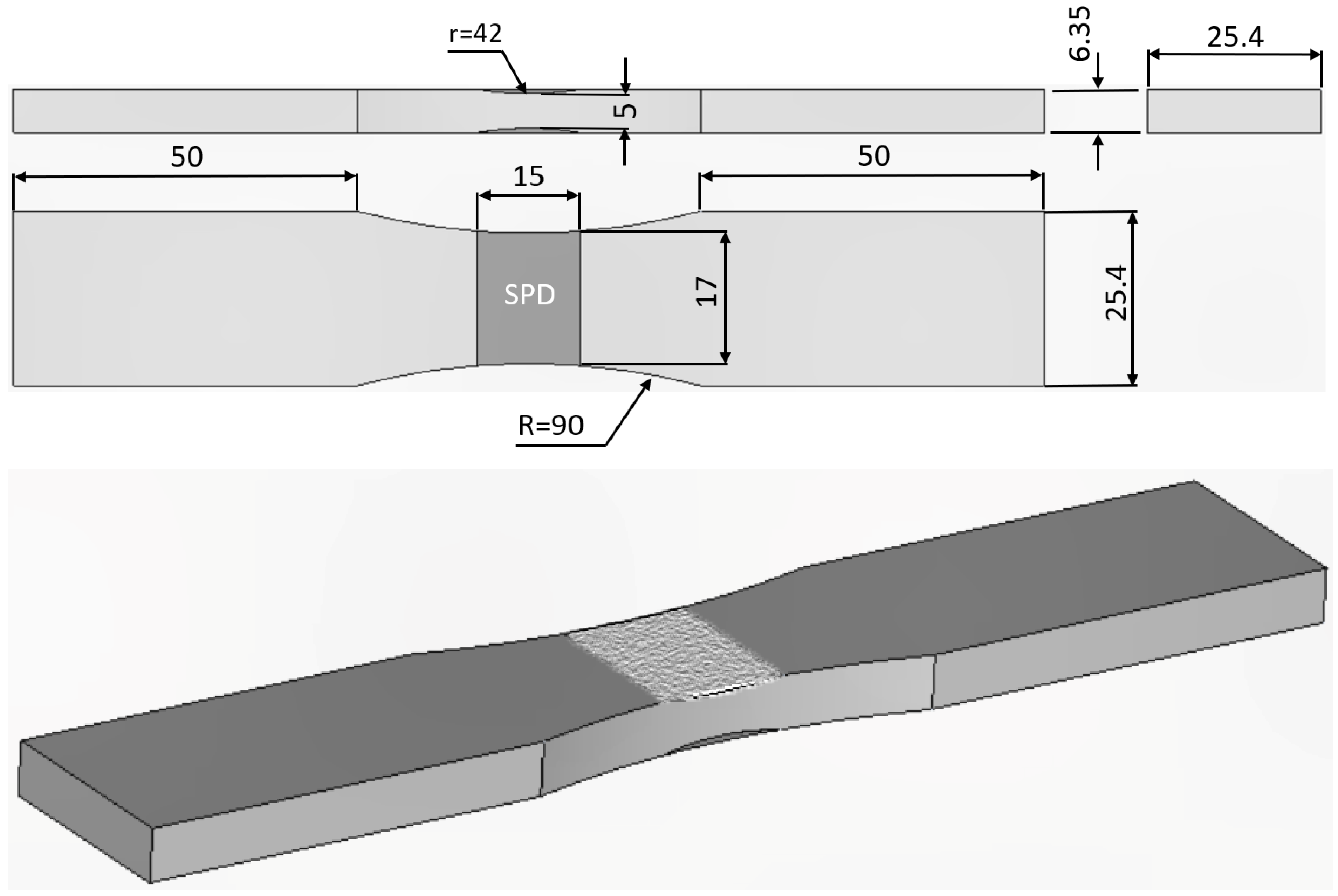

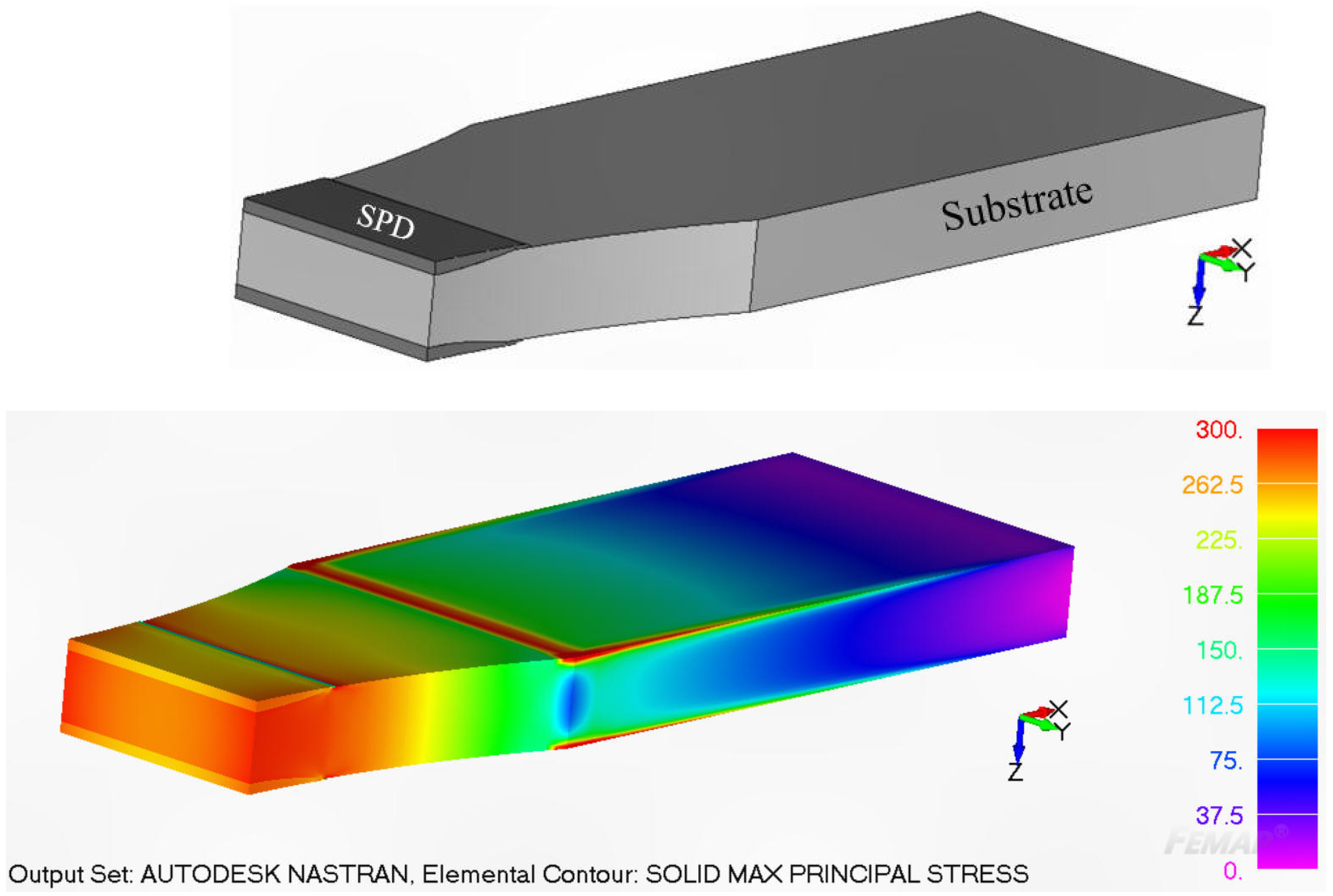

| Specimen ID | Block Loading Spectrum | Thickness of Cold Spray Deposit (+/−0.005 mm) |
|---|---|---|
| 75_1_NC_1_#1 | 1 | 0.785 |
| 75_1_NC_1_#2 | 2 | 0.755 |
| 75_1_NC_1_#3 | 4 | 0.76 |
| 75_1_NC_1_#4 | 5 | 0.73 |
| 75_1_NC_1_#5 | 6 | 0.72 |
| 75_1_NC_2_#2 | 1 | 0.818 |
| 75_1_NC_2_#3 | 3 | 0.735 |
| 75_1_NC_2_#4 | 5 | 0.74 |
| 75_1_NC_2_#5 | 5 | 0.73 |
| B_1_1_#1 | 3 | 0.935 |
| B_1_1_#2 | 5 | 0.925 |
| B_1_1_#3 | 5 | 0.14 |
| Specimen ID | Crack ID | Simplified Specimen and Crack Identifier | Starting Crack Length (mm) | ΔKthr (MPa √m) |
|---|---|---|---|---|
| 75_1_NC_1_#1 | 1 | 1-1 | 0.0246 | 0.64 |
| 2 | 1-2 | 0.0280 | 0.69 | |
| 3 | 1-3 | 0.0269 | 0.61 | |
| 75_1_NC_1_#2 | 1 | 2-1 | 0.0327 | 0.09 |
| 2 | 2-2 | 0.0353 | 0.10 | |
| 75_1_NC_1_#3 | 1 | 3-1 | 0.0260 | 0.10 |
| 2 | 3-2 | 0.0261 | 0.173 | |
| 75_1_NC_1_#4 | 1 | 4-1 | 0.0180 | 0.135 |
| 2 | 4-2 | 0.0330 | 0.176 | |
| 3 | 4-3 | 0.0780 | 0.33 | |
| 75_1_NC_1_#5 | 1 | 5-1 | 0.0463 | 0.29 |
| 75_1_NC_2_#2 | 1 | 6-1 | 0.0180 | 0.47 |
| 75_1_NC_2_#3 | 1 | 7-1 | 0.0300 | 0.06 |
| 2 | 7-2 | 0.0275 | 0.07 | |
| 3 | 7-3 | 0.0310 | 0.05 | |
| 4 | 7-4 | 0.0410 | 0.07 | |
| 75_1_NC_2_#4 | 1 | 8-1 | 0.0726 | 0.23 |
| 75_1_NC_2_#5 | 1 | 9-1 | 0.0263 | 0.150 |
| 2 | 9-2 | 0.0342 | 0.252 | |
| 3 | 9-3 | 0.0255 | 0.143 | |
| B_1_1_#1 | 1 | 10-1 | 0.0800 | 0.268 |
| 2 | 10-2 | 0.0839 | 0.32 | |
| B_1_1_#2 | 1 | 11-1 | 0.0400 | 0.275 |
| B_1_1_#3 | 1 | 12-1 | 0.0480 | 0.20 |
| 2 | 12-2 | 0.0120 | 0.05 |
Disclaimer/Publisher’s Note: The statements, opinions and data contained in all publications are solely those of the individual author(s) and contributor(s) and not of MDPI and/or the editor(s). MDPI and/or the editor(s) disclaim responsibility for any injury to people or property resulting from any ideas, methods, instructions or products referred to in the content. |
© 2024 by the authors. Licensee MDPI, Basel, Switzerland. This article is an open access article distributed under the terms and conditions of the Creative Commons Attribution (CC BY) license (https://creativecommons.org/licenses/by/4.0/).
Share and Cite
Peng, D.; Tang, C.; Watts, J.; Ang, A.; Raman, R.K.S.; Nicholas, M.; Phan, N.; Jones, R. Durability Analysis of Cold Spray Repairs: Phase I—Effect of Surface Grit Blasting. Materials 2024, 17, 2656. https://doi.org/10.3390/ma17112656
Peng D, Tang C, Watts J, Ang A, Raman RKS, Nicholas M, Phan N, Jones R. Durability Analysis of Cold Spray Repairs: Phase I—Effect of Surface Grit Blasting. Materials. 2024; 17(11):2656. https://doi.org/10.3390/ma17112656
Chicago/Turabian StylePeng, Daren, Caixian Tang, Jarrod Watts, Andrew Ang, R. K. Singh Raman, Michael Nicholas, Nam Phan, and Rhys Jones. 2024. "Durability Analysis of Cold Spray Repairs: Phase I—Effect of Surface Grit Blasting" Materials 17, no. 11: 2656. https://doi.org/10.3390/ma17112656
APA StylePeng, D., Tang, C., Watts, J., Ang, A., Raman, R. K. S., Nicholas, M., Phan, N., & Jones, R. (2024). Durability Analysis of Cold Spray Repairs: Phase I—Effect of Surface Grit Blasting. Materials, 17(11), 2656. https://doi.org/10.3390/ma17112656









